Growingmedicinal cannabis in greenhouses is efficient and much less taxing on the environment and pocketbook than gardening indoors. Unheated or heated-and-cooled greenhouses extend seasons and protect plants from the elements. Containerized plants are mobile, raised beds warm early, or you can plant directly in the ground. Greenhouses can also be equipped with lights to extend vegetative growth or augment natural sunlight. Greenhouses can be blacked out to induce flowering with a 12/12 day/night schedule during the summer.
The type of structure you select depends on the size and location of your growing area, your budget, and how much time you can dedicate to your garden. Small, movable, “pop-up” greenhouses are convenient and practical. Simple cold frames and greenhouses can be assembled from common materials such as old framed windows and 2 × 4s (5.1 × 10.2 cm). Small heated-and-cooled greenhouses are a little more complex. Hoop houses are inexpensive, practical, and easy to install. Large commercial greenhouses are best purchased from and installed by professionals. A good specialized greenhouse can be used year round in most climates. However, heating and cooling costs vary in relation to climate and seasonal weather changes.
When deciding on a garden structure, first take a look at your budget in terms of both money and time. Greenhouses can be just as much or more work as an indoor garden. Start with a small greenhouse and learn the ins and outs of growing in your climate. Greenhouses tend to warm up quickly when the heat of the sun hits them, and cool rapidly when the sun goes down. Keeping the temperature from fluctuating too much can be difficult. It takes understanding, experience, and a little luck to master temperature management.
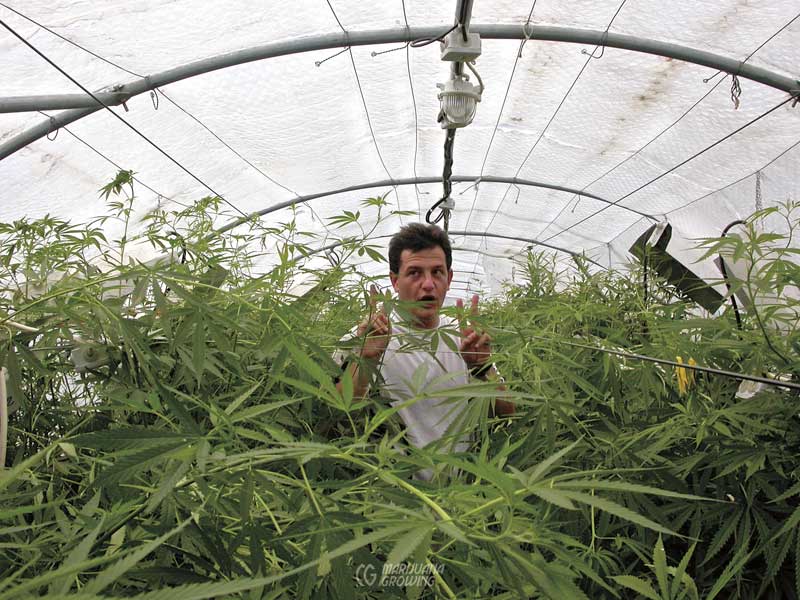
Growing in a greenhouse is easy once the structure is set up and covered. Plants often grow so fast that they fill the entire greenhouse!
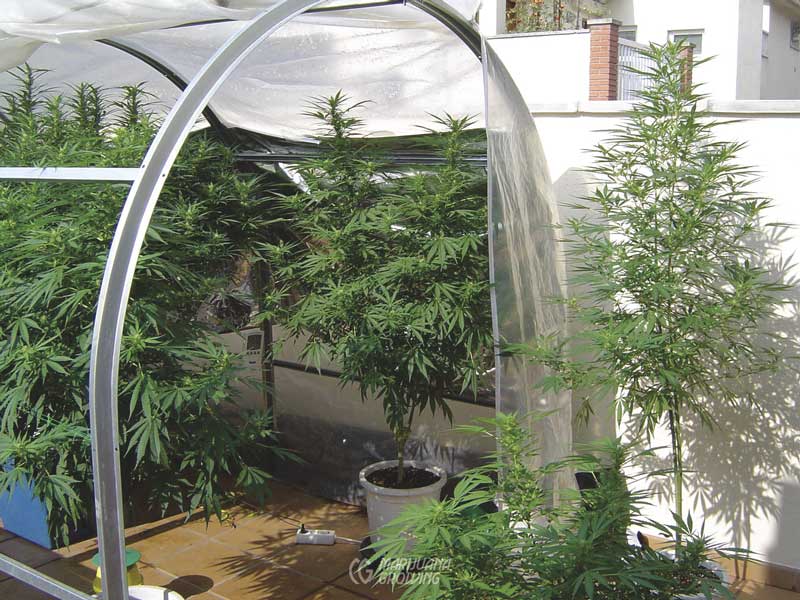
Plant in the earth or in containers when growing in a greenhouse. This gardener is experimenting with growing the same varieties in soil and in containers.
Start your greenhouse project by considering how much area you have for the footprint and how much space you will need for the desired number of plants. Think about how many plants you can grow. For example, if allowed to grow only 6 plants outdoors, they should be big plants.
Here are some great greenhouse sites to get you started:
Greenhouses must have:
• full sun to partial midday shade
• proper air circulation and ventilation
• good humidity and pest control
• water-resistant electrical outlets
• a hose bib to provide water
• insulated water lines to avoid freezing, if necessary
• tables, benches, and places to hang plants (if they are not on the floor)
• a dry place to store fertilizers, potting soil, and tools
Siting the Greenhouse
Choosing a site for the greenhouse may be easy because certain factors—size of backyard, property limits, location of existing buildings and trees, and so on— may already limit location possibilities.
Greenhouses can be temporary or permanent. Permanent structures are more expensive to construct and may require a building permit.
No matter what, greenhouses should receive ample light, especially when plants are flowering. However, midday sun could create more heat and problems than simple cooling and shading are able to control economically. In such a case, it is advisable to site the greenhouse in filtered sun or so that it is under filtered sunlight or a shadow during the hottest part of the day.
Unless square or round, site the greenhouse so that the sun passes from one end to the other rather than from one side to the other. This way plants receive the most direct light possible in relation to the path of the sun. Shadows are reduced to a minimum when the greenhouse is oriented parallel to the arc of the sun.
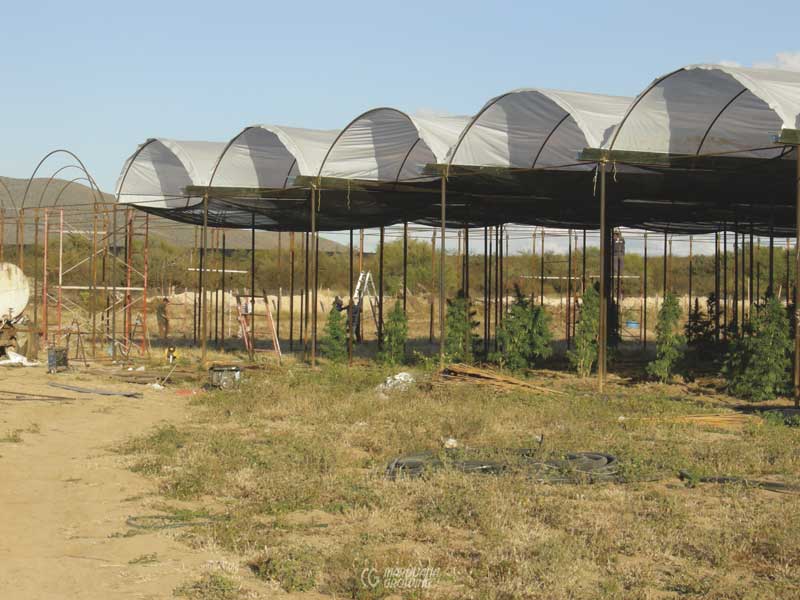
Site the greenhouse where it will receive full sun all day long. Remember, though, that the sun may need to be blocked with shade cloth to cool the greenhouse.
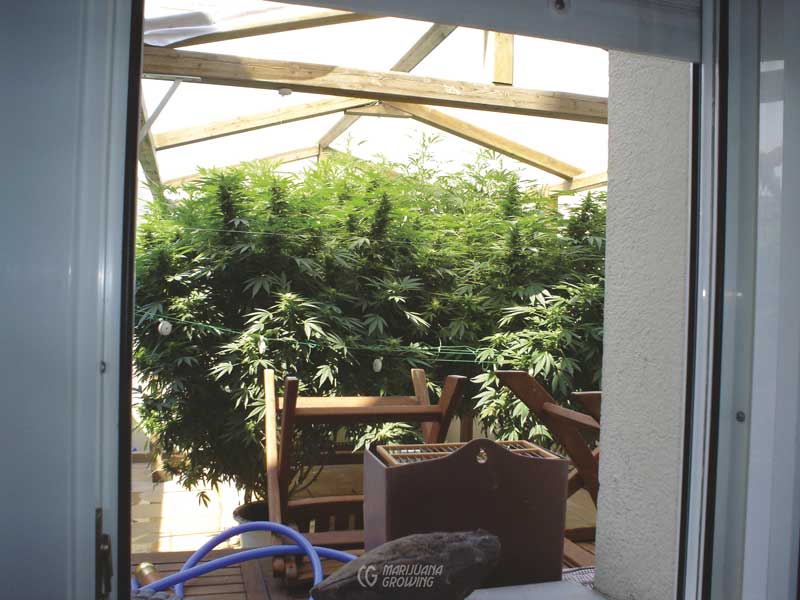
This greenhouse is located inside a large toolshed. The walls are white, and the ceiling is clear plastic to let in sunlight. Discreet greenhouses help keep neighborhood relations pleasant.
The site will dictate how plants are able to grow. A good site has:
• super soil
• lots of light
• good ventilation
• nutrients
• water
• flat land
• easy access—you are able to drive to it to provide the tender loving care your plants deserve
Location and exposure will depend on climate, but in general, you will want the greenhouse to receive ample sunlight yet not be exposed to strong winds. The structure should be away from any areas where falling limbs or other debris might create problems. Greenhouses in hot and tropical climates will require more shade and water. See “Sunlight and Siting the Garden” in chapter 12, Outdoors, which is full of pertinent information.
Types of Greenhouses
The type of greenhouse you choose is governed by your climate, your budget, and your desires. The first consideration is climate. An unheated greenhouse in the mild Pacific Northwest can easily extend spring and fall growing seasons by 6 weeks each, 3 months total. Coastal California gardeners can grow all year in the same greenhouse and spend little on heating or cooling. With a little heat and proper setup, a greenhouse can produce nearly year round in Michigan and other northern climates. But be careful when planting early in the year. Plants outgrow the confines of the greenhouse and are difficult to cover before harvest if weather is rainy.
Use miniature greenhouses—cloches, plastic milk jugs, Wall O Water, and so forth—to extend the spring planting season by 2 to 6 weeks. Miniature greenhouses protect plants from cold weather and wind. They are easy to use when hardening-off cannabis transplants too. In many climates, extending the spring season could allow a gardener enough time to plant both a spring crop and a fall crop.
Cloches are individual protective coverings that keep plants warm at night. A simple cloche is a plastic milk container with its bottom cut off and its lid removed. Placed over a plant, the plastic will capture and retain heat while allowing ventilation through the open top. Make cloches out of wax paper, glass, or jars. You can also buy commercial units made of rigid, transparent plastic or heavy-duty wax paper. They are easy to use and stack well for storage.
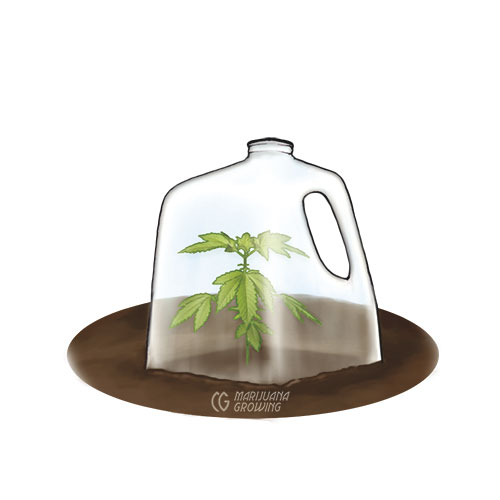
Cut the bottom from a plastic container to form a cloche. Remember to remove the lid for ventilation.
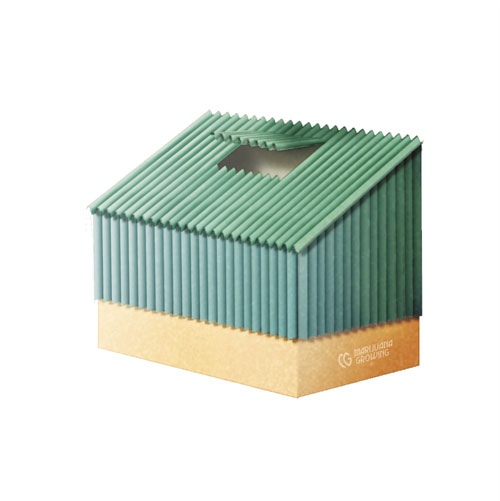
Cover greenhouses with corrugated fiberglass to exclude inquisitive passersby.

A window box greenhouse or freestanding greenhouse is a great place to start seedlings and clones. With enough light, vegetative plants do well. Most window box greenhouses are too small to accommodate large flowering plants.
The Wall O Water is a plant lifesaver. It is a water-filled teepee that uses the heat-emitting properties of water to shield plants from excess heat and keep them warm in the cold. It holds 3 gallons (11.4 L) of water and fits over the plant. During the day, the water absorbs the heat of the sun, moderating the temperature inside the teepee. At night, as the air temperature drops, the water releases its heat, keeping the plant comfortable. The Wall O Water does its best work in the spring when there is still a chance of freezing. As water freezes, it releases more heat into the teepee and can protect plants down to 20°F (-7°C).
Covers protect early transplants and can help produce a spring crop. The simplest option is a lightweight row cover spread over the plants and held down with stones or soil. Spun-fiber products Agronet and Reemay also have sun protection properties that can be used as covers in place of the sheet or blanket.
Low-profile greenhouses are perfect for crops of short plants. It is easy to set up a low-profile hoop house or greenhouse alongside a building that gets full sun. The short greenhouse or cold frame is easily darkened during full summer and lets you reap the benefits of the harvest early! (See “Light Deprivation”
A lean-to or attached greenhouse uses an existing structure for one or more sides. The wall of the structure provides stability and free heat if it is warmed by sunlight. Attached greenhouses are usually close to water and electricity; however, light might be lacking due to poor siting or orientation. If the wall gets too hot, it can be covered with white plastic to reflect light and cool the wall.
The freestanding greenhouse offers the most flexibility in size and location. It can be built to take full advantage of the sun, but it does not retain heat well and can be expensive to keep warm. Numerous steps can be taken to minimize heating and cooling costs and environmental impact of maintenance. Many frame types and coverings are available in kits or raw materials. Coverings can also be easy to open for ventilation. There are also a number of good websites listed at the beginning of this chapter to help you choose the plan that works best for you.
Hoop houses are inexpensive, practical, and easy to build. They can be made to cover raised beds or be constructed on flat ground. They consist of a series of parallel PVC plastic or more durable steel pipes arched over two points of anchor. The arches are connected across the top with a stay to add strength to the structure. A plastic skin is secured over the arches with tape or removable clamps. Ends can be closed or kept open at night for ventilation.
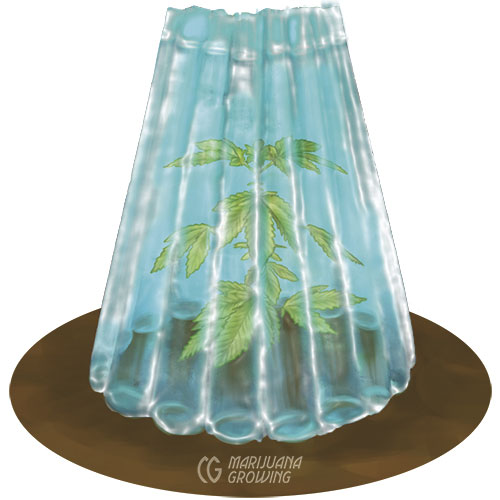
A Wall O Water will keep plants warm when temperatures approach the freezing point.
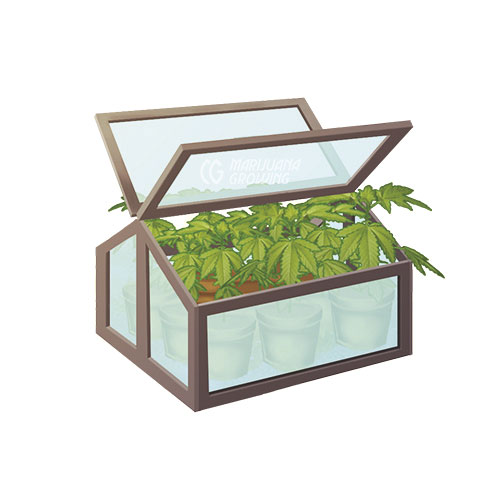
Garden stores sell many different kinds of small greenhouses.
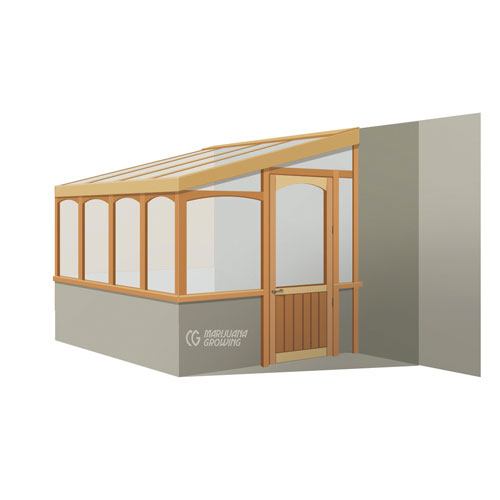
A lean-to greenhouse uses heat from the house wall to stay warm..
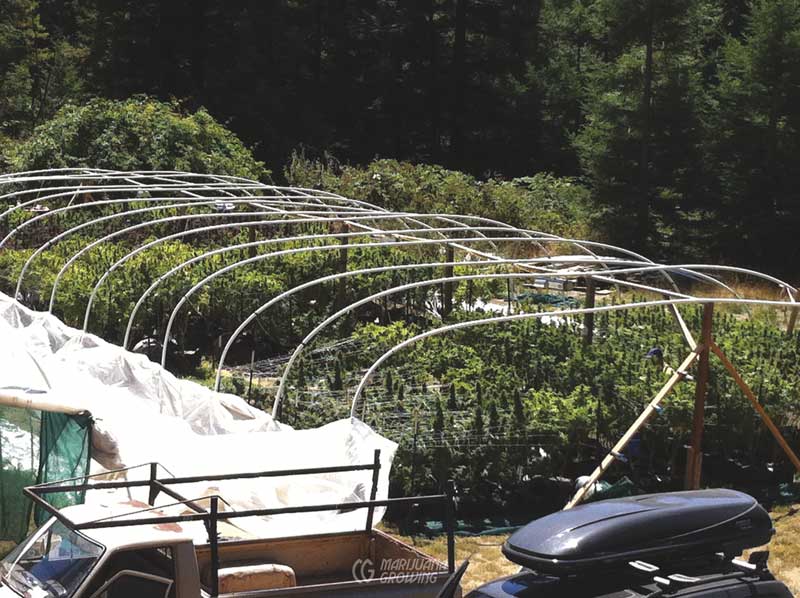
A crop of 1–2-foot-tall (30.5–61 cm) clones or seedlings planted on May 1 can be harvested in mid-July in a greenhouse that is darkened for 12 hours daily.
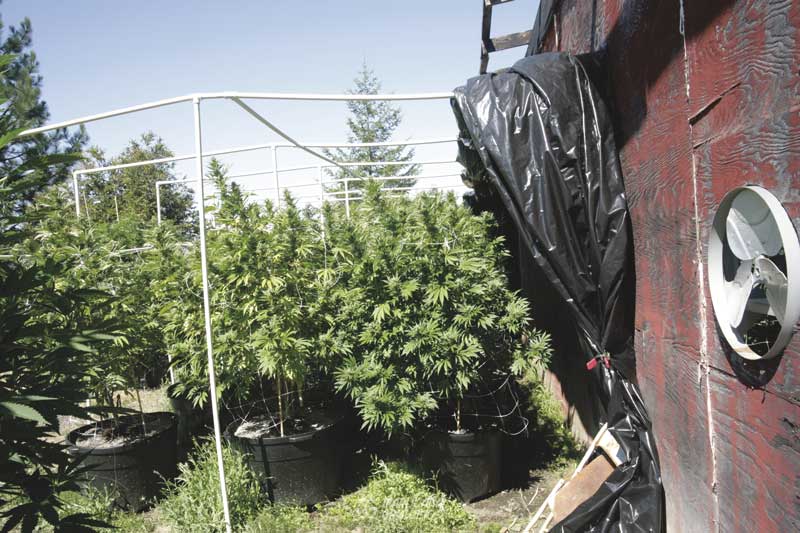
This greenhouse was built next to a sunny barn wall. The wall holds heat and protects the garden from wind.
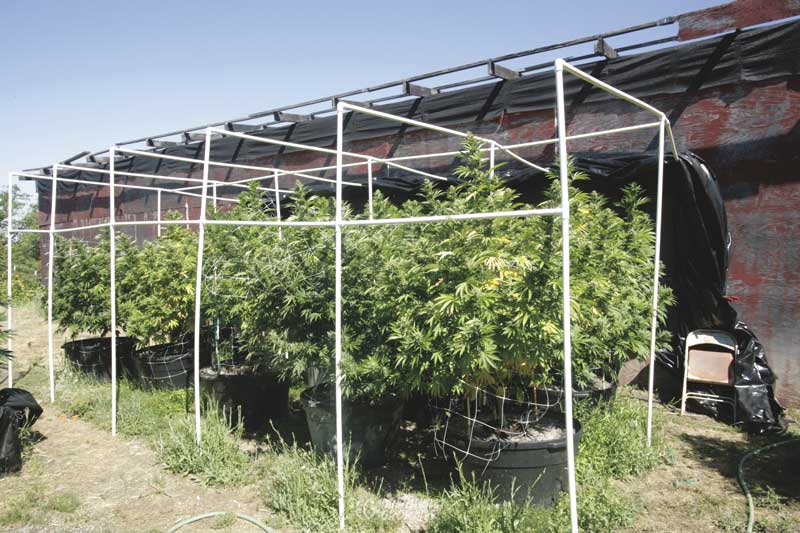
The black plastic is pulled over the PVC irrigation pipe frame of the greenhouse every afternoon to give the plants 12 hours of uninterrupted darkness to induce flowering.
The outer skin can be manually removed during hot weather and replaced during cool nights. Once the plants outgrow the plastic skin it is removed. It is replaced with a 6-inch (15.2 cm) plastic mesh that supports and trellises the plants as they grow.
Hoop greenhouses with removable plastic coverings work well when growing medium-to-large plants. The plastic is removed when weather warms and is replaced with 6-inch (15.2 cm) plastic mesh that acts as a trellis to keep branches from breaking under the weight of buds. See chapter 11, Greenhouses, and chapter 13, Case Studies, for more information.
Hoop houses are inexpensive as well as quick and easy to set up. Plants can be moved in before or after a hoop house is set up. Once plants outgrow them, hoop-house structures turn into trellises to help support heavy flowering plants.
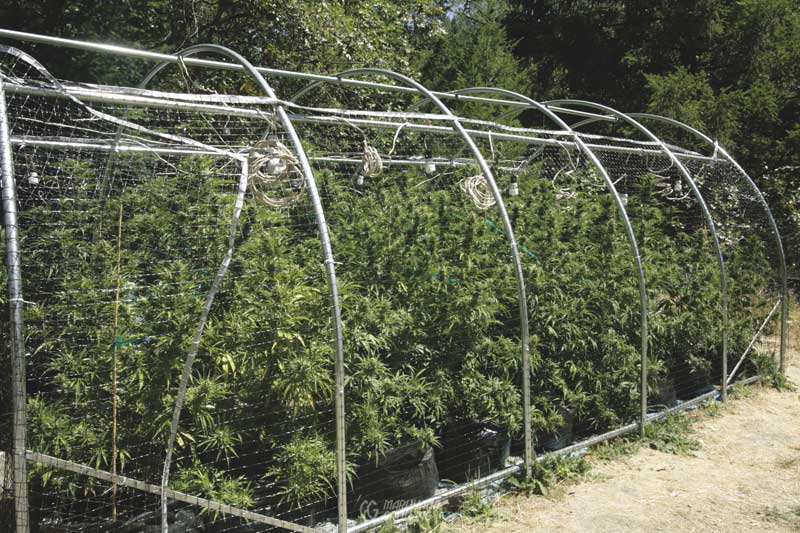
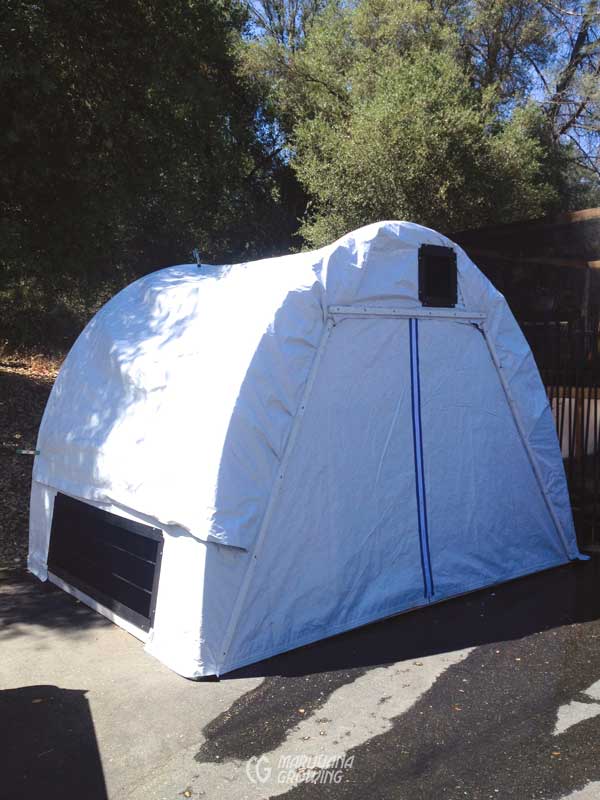
This prefabricated greenhouse comes with its own covering for blackout. The covering comes equipped with ventilation inlets and outlets.
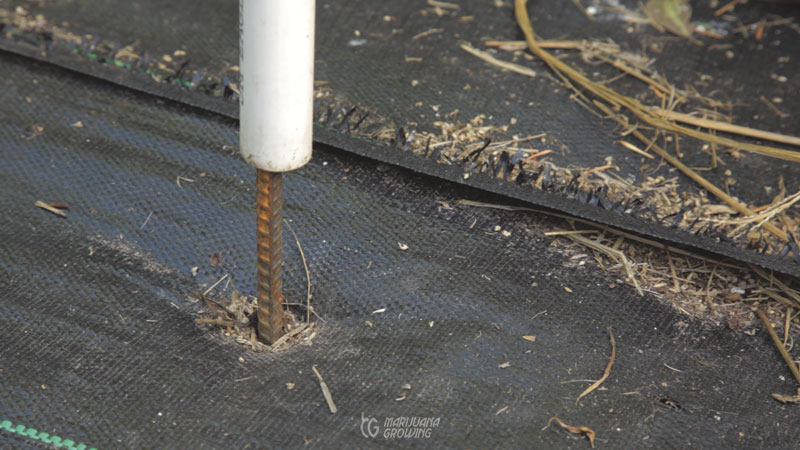
Hoop houses are easy to set up. First, weed barrier cloth is set down and secured. The greenhouse is laid out in a grid in sections measuring 10 × 8 feet (3 × 2.4 m). Two-foot-long (0.6 m ) steel rebar stakes are driven through the weed barrier and halfway into the ground.
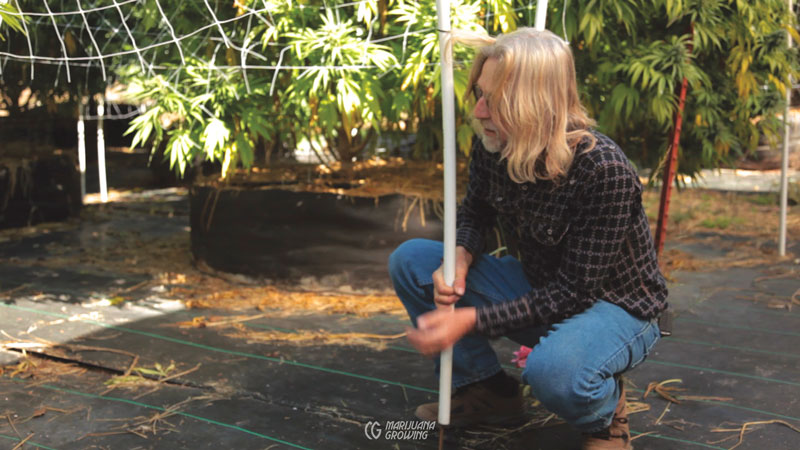
Slide a 20-foot (6.1 m) piece of schedule 40, 0.075-inch (1.9 mm) PVC irrigation pipe over 2 opposing pieces of rebar 10 feet (3 m) apart to form an arch.
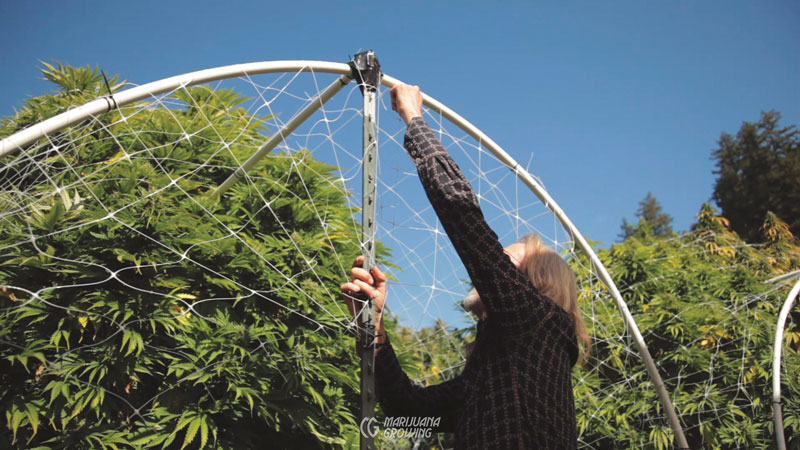
Several arches are erected and connected with individual pieces of PVC irrigation pipe secured with duct tape. A long, steel fencepost provides added stability. The hoop house is covered with plastic in the spring. When hot summertime weather arrives, the plastic is replaced with trellis netting.
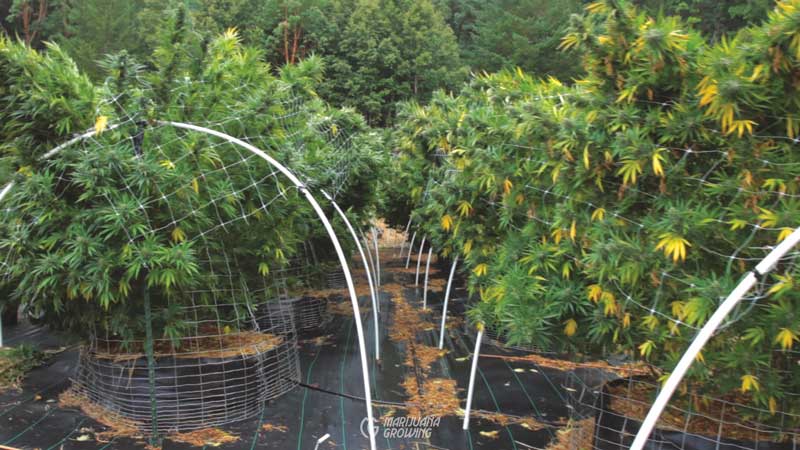
Hoop houses are inexpensive as well as quick and easy to set up. Plants can be moved in before or after a hoop house is set up. Once plants outgrow them, hoop-house structures turn into trellises to help support heavy flowering plants.
Prefabricated greenhouse kits are more expensive but come with all the parts and assembly instructions. They can be complicated to assemble. Some may offer a video to help with assembly. Often you can find small and miniature portable greenhouses at home improvement centers and on the Internet. Medical gardeners interested in larger greenhouses can see interesting automated greenhouse videos by searching for “forever flowering greenhouse” on YouTube.
Setting up a big commercial greenhouse is beyond the scope of this book. Search for “commercial greenhouse” using an Internet browser and you will find all the greenhouses you could want!
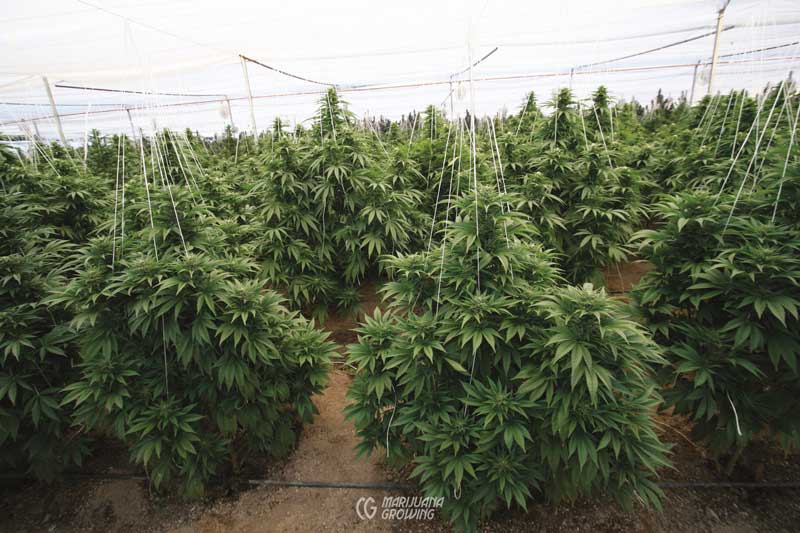
Adequate airspace is often forgotten when growing in a greenhouse. This Mexican greenhouse has plenty of extra space to let air circulate.
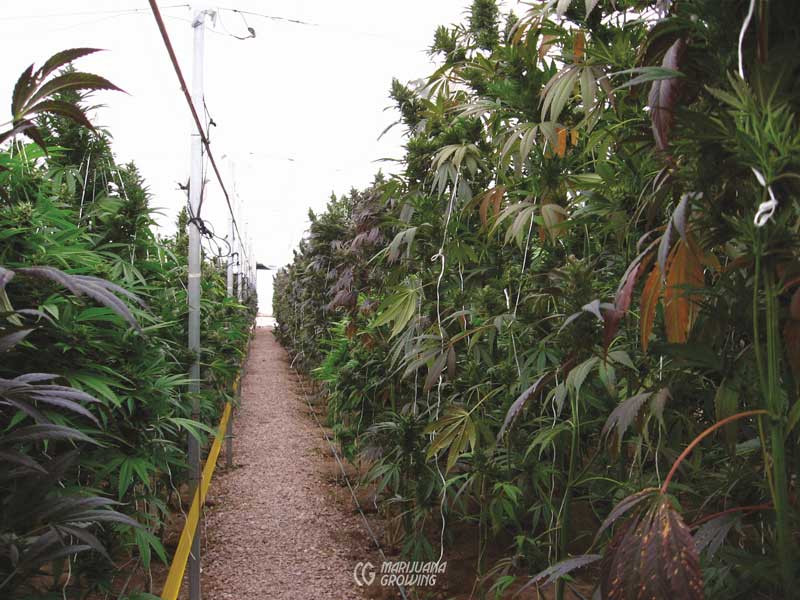
Always leave enough walkway space so that a wheelbarrow or small cart can pass through. Overplanting greenhouses makes maintenance difficult and cuts air circulation.
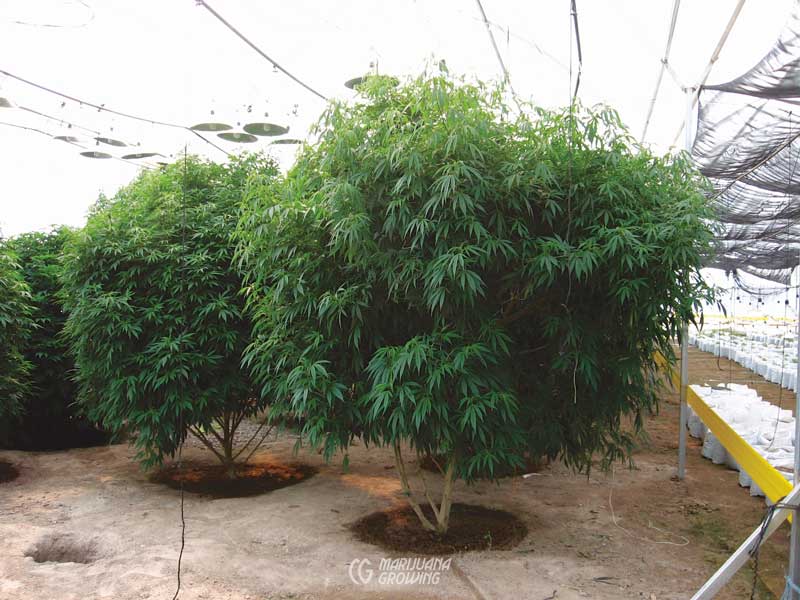
Big plants grow well in the greenhouse floor. In hard clay soils, a large planting hole filled with well-amended organic soil is as good as a large aboveground fabric container.
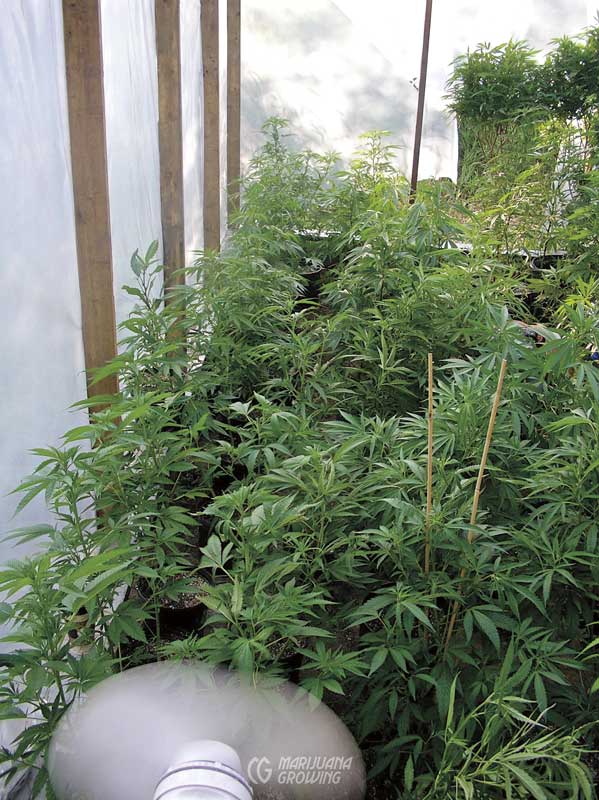
This greenhouse was framed with inexpensive lumber.
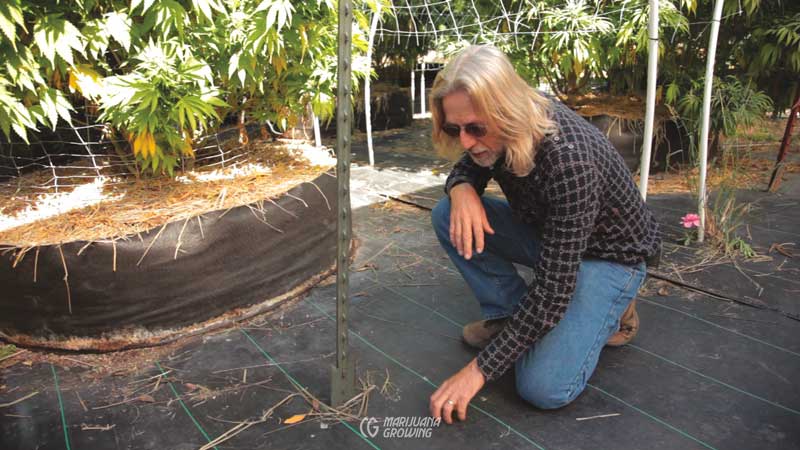
A weed barrier helps retain moisture and prevents many soil-borne insects from having easy access to the greenhouse. This medical cannabis gardener ran the weed barrier outside the greenhouse for extra protection. It also keeps mud away and makes the garden floor easy to clean.
Greenhouse Construction
Both large and small greenhouses cost money, time, and space. Greenhouses with a foundation are also more permanent. Regardless of the type of greenhouse you construct, it should be on flat ground and have easy access.
This section of the chapter on greenhouses discusses different construction options, touching on main points to consider. However, providing construction instructions with diagrams is beyond the scope of this book. For more specific information, type “greenhouse plans” into an Internet browser.
Size of Greenhouse
Total area of the greenhouse is determined by the number of plants you intend to grow and how long they will be in the ground or in pots. The longer plants grow, the more room they will need and the more problems that can occur. Induce plants to flower when they are 3 feet tall, and allow a minimum of 1 square yard (0.8 m2) for indica-dominant varieties and up to twice as much space for sativa-dominant varieties. Air circulation between plants can be a problem if plants become too big. Large plants that are planted early in the season often outgrow the greenhouse, which requires that the outside skin of the greenhouse be removed so growth is not impaired.
Ample airspace is essential in greenhouses. At least half the space in a greenhouse should be airspace. This space is necessary for air exchange, air circulation, and ventilation. Molds, mites, and insects become problems in greenhouses with inadequate airspace. As a general rule, plants should take up about 0.33 to 0.5 percent of the space in a greenhouse and air 0.5 to 0.66 percent. This ratio allows adequate air circulation.
Framing
Framing can be wood, bamboo, metal, or plastic. Framing to specific dimensions and building with premade framed panels has the advantage of quick installation and breakdown for winter storage. Build all structures using standard dimensions for framed glass, plastic panels, and sheeting to get the most from your materials and work more efficiently. For example, an 8-foot (2.4 m) greenhouse can be made with two 48-inch-wide (122 cm) fiberglass panels. Center height depends on the level of the eaves. Low-growing plants can take an eave of 5 feet (1.5 m); tall plants need 10 to 14 feet (3–4.3 m).
Greenhouse walkway space is important for easy access. Too many gardeners are surprised when it turns into “crawling room only!” Overgrown foliage in large or small greenhouses cuts air circulation and promotes disease and pest attacks, as well as broken foliage. Room to move a wheelbarrow in a large greenhouse is especially valuable when plants grow beyond beds.
The floor of the greenhouse can be covered with weed barrier cloth, gravel, bricks, or concrete. Place a thermal blanket under floor covering to insulate from cold ground. A Styrofoam base in a small greenhouse keeps cold soil from cooling containers and greenhouse. You can also make raised, flat, or sunken beds in the greenhouse floor. Dirt floors can get muddy and are difficult to keep “clean.” Cover muddy floors with sawdust or straw. A wood, brick, or concrete base around the bottom of the greenhouse adds stability to the structure.
Planting in the earth floor of the greenhouse allows you to use organic methods. The plants cannot be moved easily, but they grow bigger and require less maintenance than container-grown plants. Without containers, plants also retain a lower profile, but I still like raised beds. Growing in Mother Earth is always better than planting in pots when growing big plants. Most all the principles that apply to outdoor growing apply to growing in a greenhouse, too. Check out chapter 12, Outdoors, and chapter 18, Soil, for more information.
Benches
A greenhouse equipped with benches makes tending plants much easier. Water catchment systems can also be set up to recycle nutrient solution. I like a greenhouse with tables because when plants are off the floor, they stay warmer and are easier to access. Airspace below benches can serve as storage area for containers and water reservoirs.
Set up tables along the length of the greenhouse to make the best use of space. Allow at least 3 feet (91.4 cm) between tables and greenhouse walls to accommodate plant growth and provide for comfortable access.
Metal benches are much stronger and more durable than wood but they are expensive. Frame wooden benches with enough lumber to support the center of tables. Cover wood with waterproof epoxy paint or set plastic ebb-and-flow tables on benches.
Hoop-House Construction
Mark a rectangular area 6 to 10 feet (1.8–3 m) wide and up to 50 feet (15.2 m) long where the greenhouse will be located. Purchase 20-foot lengths (6.1 m) of 0.75-inch (1.9 cm) Schedule 40 PVC pipe for every 4 to 8 feet (1.2– 2.4 m) of greenhouse. Two 2-foot-long (0.6 m) pieces of 0.5-inch (1.3 cm) rebar are necessary to anchor each end of the PVC pipe in place. Larger, stronger steel hoops can be ordered from greenhouse supply outlets.
Drive the 2-foot (61 cm) rebar 1 foot (30.5 cm) into the ground on 4- to 10-foot (1.2 to 3 m) centers to form a rectangle. Place each end of the 20-foot (6.1 m) PVC pipe over opposing 1-foot (30.5 cm) pieces of rebar to form an arch. Use duct tape or zip ties to attach a stay of 0.75-inch (1.9 mm) Schedule 40 PVC pipe across the top of the arches. Cover the hoops with a plastic skin and secure in place with duct tape or clamps. Remove plastic and replace with 6-inch (15.2 cm) plastic mesh that supports and trellises the plants as they grow beyond the confines of the hoops.
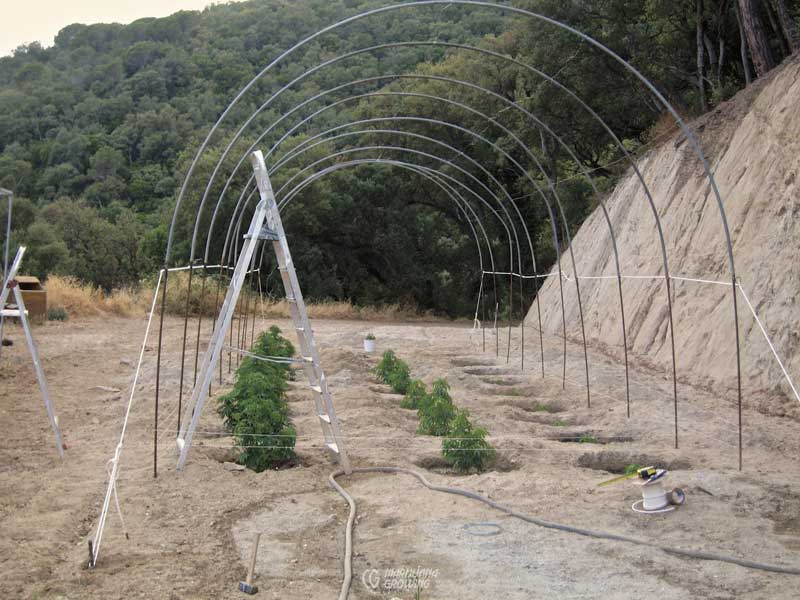
A metal hoop superstructure is constructed over small plants. Long, arced pieces are pushed into the moist earth. The superstructure is lightweight and fastened together with duct tape.
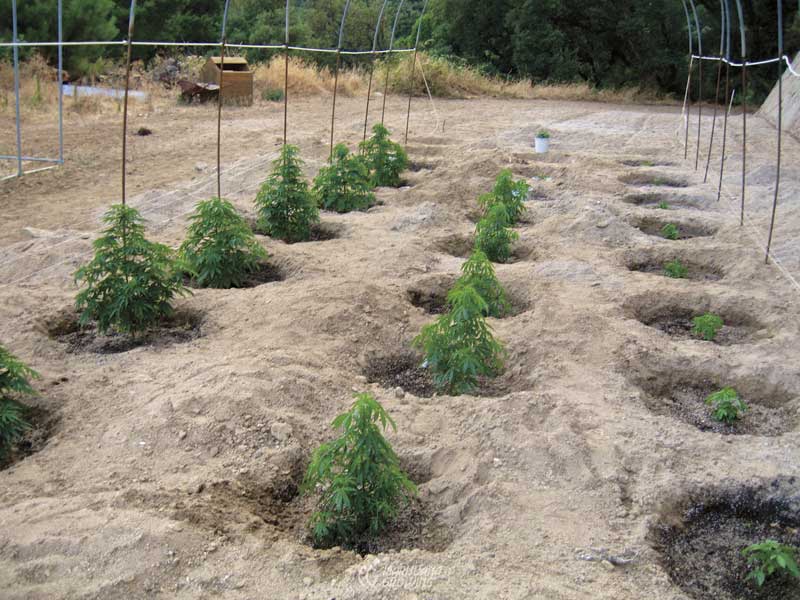
This garden was started earlier in the year in 3 different phases. The little clones are planted 2 weeks apart. Planting in sunken beds in the clay soil allows plants to stay cooler.
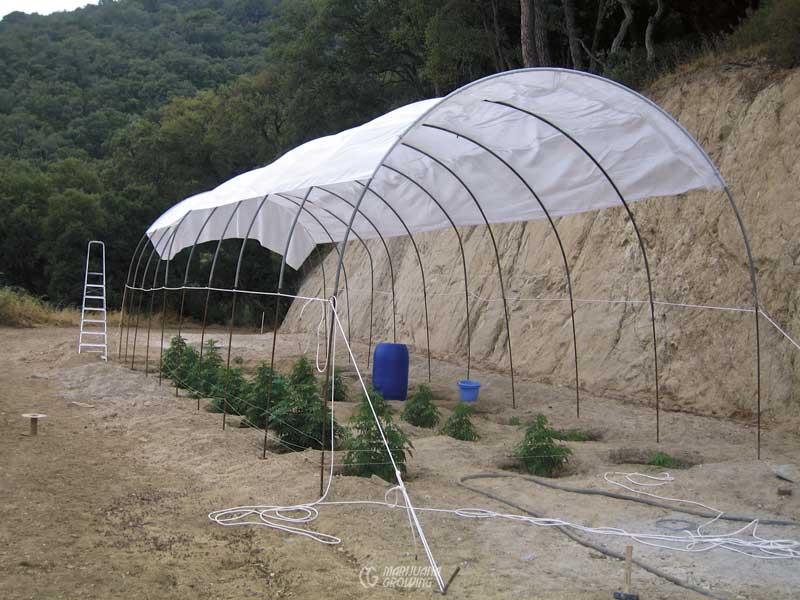
A lightweight shade cloth is stretched over the hoop house to cover the garden and provide shade during the hot days of summer.
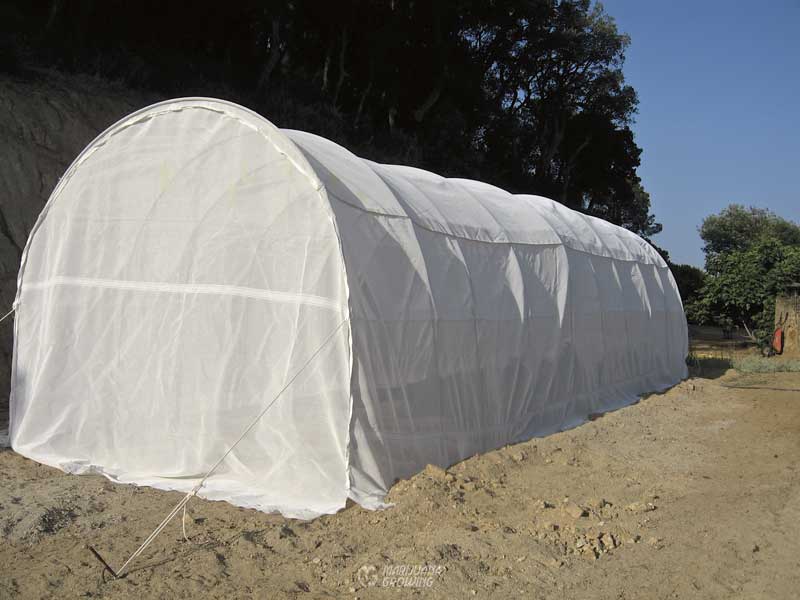
Once covered, the plants inside the hoop house cannot be seen from a distance. The shade cloth breathes so that minimal ventilation is necessary.
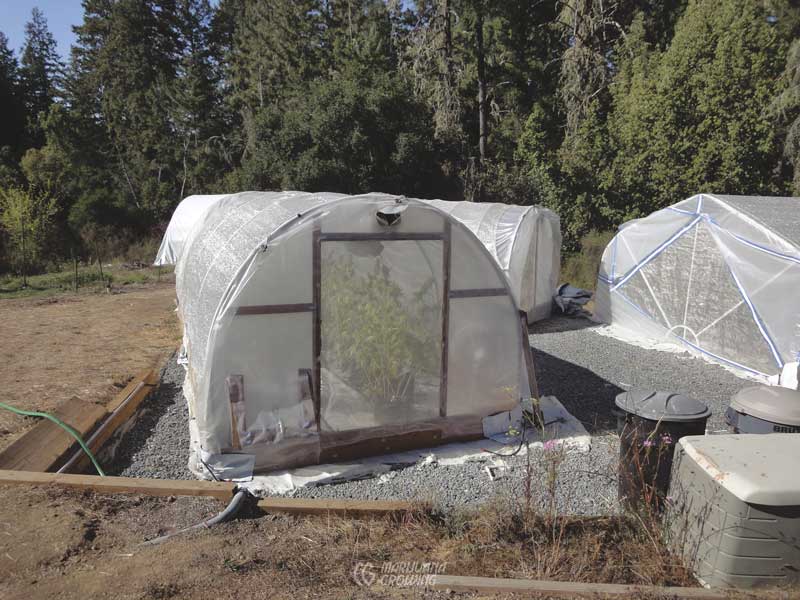
Typically a new gardener will cover a greenhouse with inexpensive plastic. A door is framed and installed, as is a vent fan. This greenhouse is covered with a light-reflecting shade cloth called Aluminet.
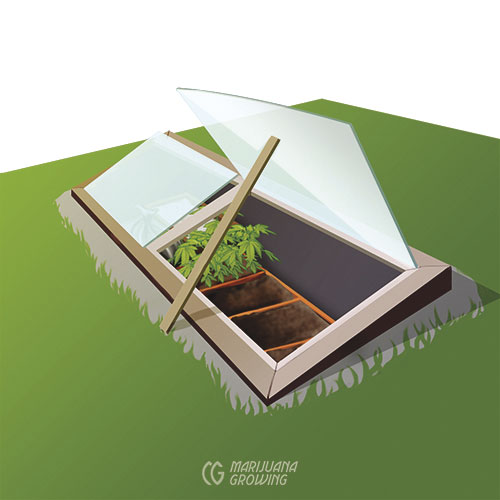
There are many interesting videos about greenhouse design, construction, heating, and so forth. Search “greenhouse construction” on YouTube for much more information.
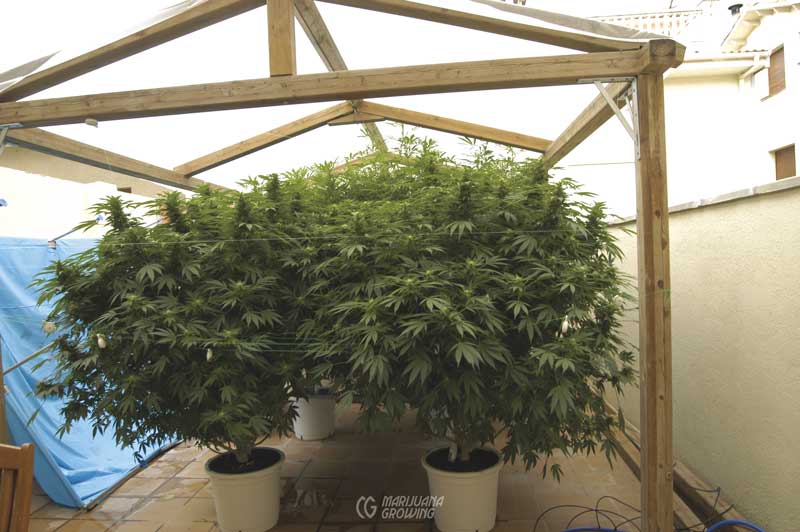
This small backyard patio greenhouse shielded plants from drizzly rain and kept plants warmer at night.
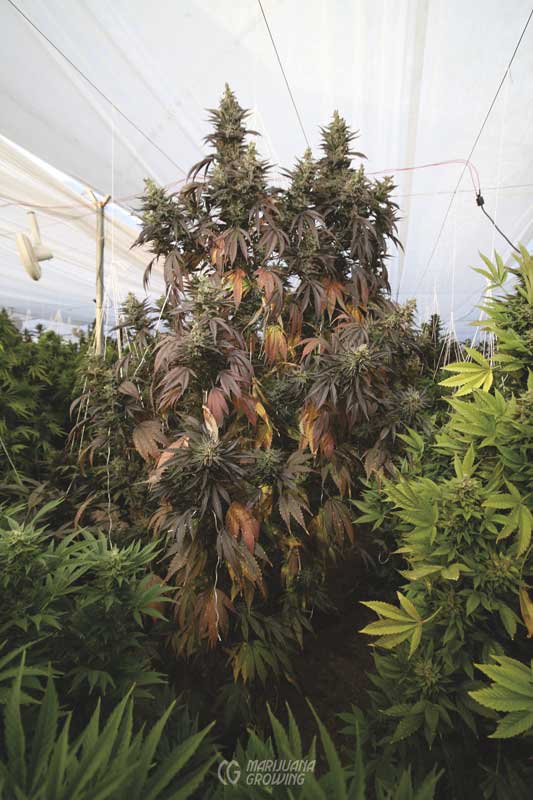
This 8-foot-tall (2.4 m) plant is growing in a large 18-foot-high (5.5 m) greenhouse. Extra airspace is needed for the transfer of carbon dioxide and oxygen.
Coverings
Greenhouse coverings protect plants from the elements, but not all are created equal. Some greenhouse coverings transmit more light than others, while some hold heat and stay cool better than others. Price and durability also vary substantially. Overall, plastic and fiberglass coverings provide safe, economical alternatives to glass. The best greenhouse films are UV (ultraviolet) resistant.
Glass greenhouses are traditional. They enjoy very high light transmission, but glass is expensive, heavy, and brittle. It is not practical for most cannabis gardeners. Keep costs down and use only small glass greenhouses. Often they can be assembled from scrap windows.
Plastic Skins
Plastic designed for greenhouses is more durable than regular plastic, which tears easily when cut. Greenhouse plastic resist rips and tears. Quality greenhouse plastic is knitted instead of formed into sheets. It costs a little more than regular plastic but withstands destructive ultraviolet light from the sun. Greenhouse plastics last for 2 to 3 years before they need to be replaced. Of course, this does not take into account extreme weather such as hurricanes, tornadoes, hail, or severe icing.
An economical plastic covering is easy to control and helps to maintain heat and humidity in the greenhouse. Clear plastic is equal to glass in producing quality plants and flower buds. Plastic greenhouse film is available in clear and white that diffuses light but still allows high light transmission.
Choose the plastic that suits your needs. How long will you need it? Can you use it and then store it to use for additional seasons? How will you secure it to the greenhouse? How will you patch holes?
Rated in mils of thickness, greenhouse plastics are from 3 to 6 mils thick (1 mil = 1 thousandth of an inch [0.054 mm]). Greenhouse plastic is designed to last for 2 to 5 years, depending on grade. Rigid panels are designed to last for 10 years or more.
Polycarbonate multiwall sheeting is lightweight, almost unbreakable, and available in double or triple hollow wall grades. Dual-wall construction makes this type of covering strong enough to withstand hailstorms, snow, and temperature fluctuations. Clear corrugated polycarbonate is very durable and has excellent light transmission.
Biodegradable plastic coverings are good for a month or two, maybe longer, depending upon the weather. These coverings are best used for a short time to cover individual clones or seedlings. Normally biodegradable plastic is available as plastic bags. Sheeting is expensive, and the short life renders it impractical.
Polyethylene plastic (PE) is low-cost, lightweight, provides ample light, and can withstand fall, winter, and spring weather. It does not tolerate summer UV levels. Ultraviolet-inhibited PE lasts longer, but both types lose heat more quickly than glass and other plastics. During the day, this can help keep plants cooler, but at night the heat loss requires the use of an artificial heat source. PE is available in commercial (6 mil) and utility (4 mil) grades. Most home improvement centers carry lighter-weight utility grade. Commercial grade is available via the Internet. Polyethylene plastic will last for a year or two when kept in good condition. Smaller tears can be repaired with a poly repair kit.
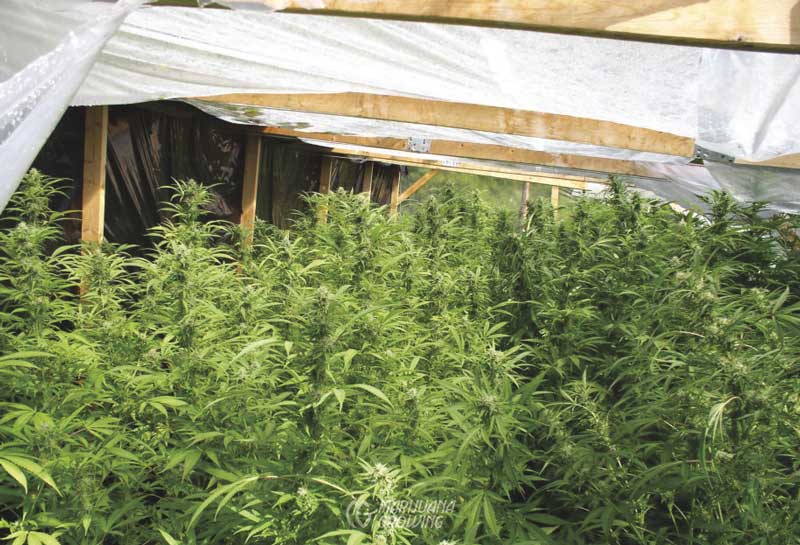
Inexpensive plastic and 2 × 4-foot (5 × 10 cm) boards and a few screws are all that is needed to construct a greenhouse. Just a little bit of work building a greenhouse will keep plants warm and dry and extend growing seasons.
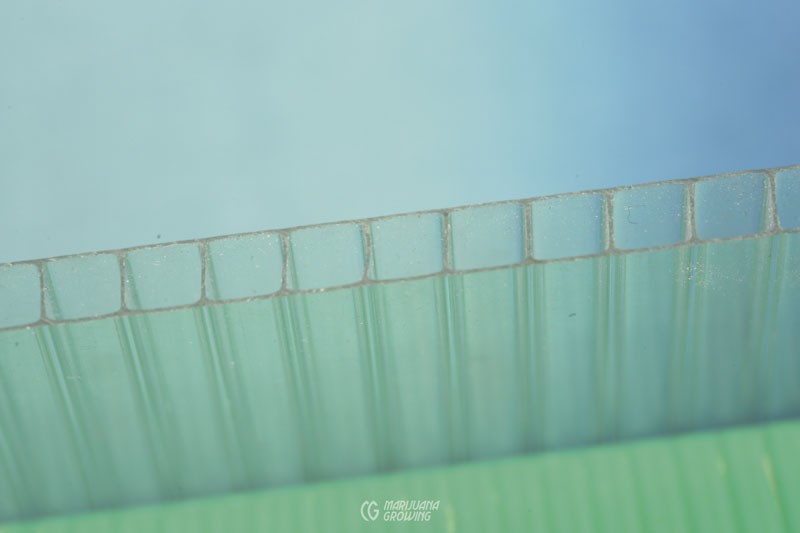
Lexan is one of the best greenhouse coverings available. The dual-wall construction traps heat between the outer panes to insulate the greenhouse. Durable Lexan lasts for years and is fairly rigid.
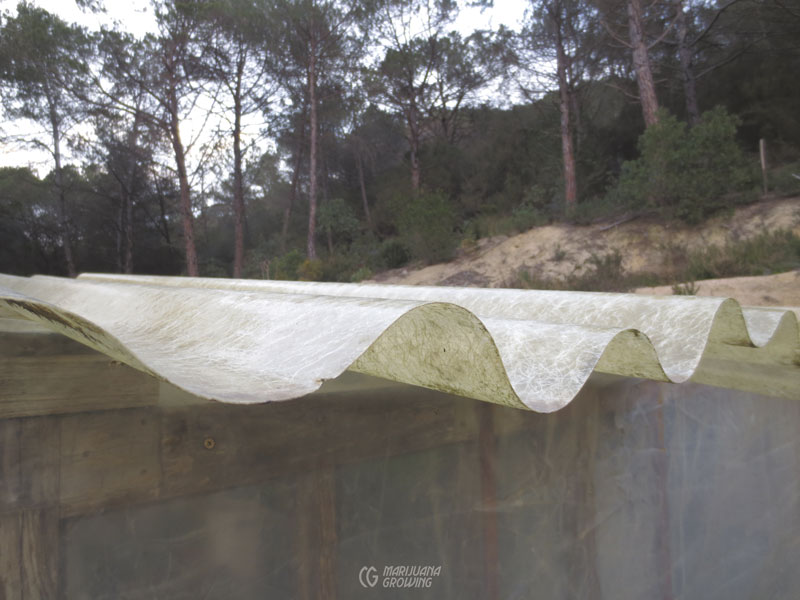
Corrugated fiberglass panels are easy to find at hardware and building supply stores.
Copolymer plastic is more durable and lasts longer than polyethylene plastic. Copolymer plastic lasts up to 3 years before becoming brittle and then breaking. Freezing and thawing will cause plastic to become brittle more quickly. More expensive copolymer plastics are more durable and equal the light transmission of glass.
Polyvinyl plastic is more durable than polyethylene or copolymer plastics. It is strong and provides structural strength when covering a greenhouse. Polyvinyl plastics will last 5 years or more when regularly maintained (cleaning it and fixing any rips or tears).
Polyvinyl chloride (PVC) is 2 to 5 times more expensive than PE but can last 5 years or longer. Polyvinylchloride is pliable and transparent or translucent, and it comes in 4- to 6-foot (1.2–1.8 m) widths that can be sealed together to provide a super wide piece. Ultraviolet-inhibited corrugated plastic panels provide another option; with their excellent insulating properties (2.5 R insulation/3.5 mm panels, 3.0 R/5.0 mm panels), these panels can be used in cold frames, propagation houses, and greenhouses to provide excellent wind and snow protection and optimal solar heat collection.
Polycarbonate plastic is the most durable plastic. The double (twin wall) construction can last up to a decade. It maintains heat and humidity well and is the best plastic covering for year-round growing in cool and cold climates.
Lexan is one of the first dual-wall greenhouse coverings. This stuff is tough! One grade is even bulletproof! This thermoplastic lasts for years. It transmits almost as much light as glass and retains more heat. Lexan is rigid and full of thermo-storing channels. Clear panels like those in glass or Lexan may require shading during the heat of the day.
Corrugated fiberglass panels are readily available in different colors from clear to black. Light transmission for corrugated fiberglass is fair to good, depending upon color. Poor grades will discolor, reducing light penetration, but a good grade of clear fiberglass can cost as much or more than glass. This covering transmits enough light under full sun conditions to grow a good crop of cannabis. It is lightweight, strong, and comes in 8- to 12-foot (2.4–3.7 m) panels. Fiberglass holds in heat in the winter and cool air in the summer.
Make sure to use clear or uncolored fiberglass panels. Colored panels will exclude light frequencies. For example, green panels will exclude both red and blue wavelengths, giving it its green color and denying plants their two main sources of energy.
Insulation is most efficiently used when the sun goes down. It is extremely important for greenhouses in cold climates. Throw a blanket, tarp or piece of “bubble plastic” over the top of the greenhouse to hold in heat at night.
Larger greenhouses have automatic coverings that cover the top half of the greenhouse from inside. The space to be heated is reduced and it is more economical to heat at night.
Small greenhouses covered in plastic can be insulated inexpensively with double-wall construction. Two skins are affixed to the superstructure frame. An air pocket is formed between the skins. Nylon rope is stretched over the outer skin in several places and anchored on either end to hold it down. A small squirrel cage blower is mounted and attached to blow air in between the skins to form a 2- to 3-inch (5–7.6 cm) insulating layer of air. Light transmission is lessened, but the insulation value of the air makes it much easier to moderate the temperature inside the greenhouse. This insulation principle is most simply and easily applied to inexpensive hoop houses.
Higher R-value coverings make heating and cooling greenhouses more efficient and cost-effective. An efficient LP gas, propane, or kerosene heater will keep the greenhouse warm at night and during cold spells, but water vapor and high humidity are the by-products. Evaporative swamp coolers are the ideal way to keep greenhouses cool during hot summer temperatures, however, these coolers are less effective as temperatures and humidity rise outdoors.
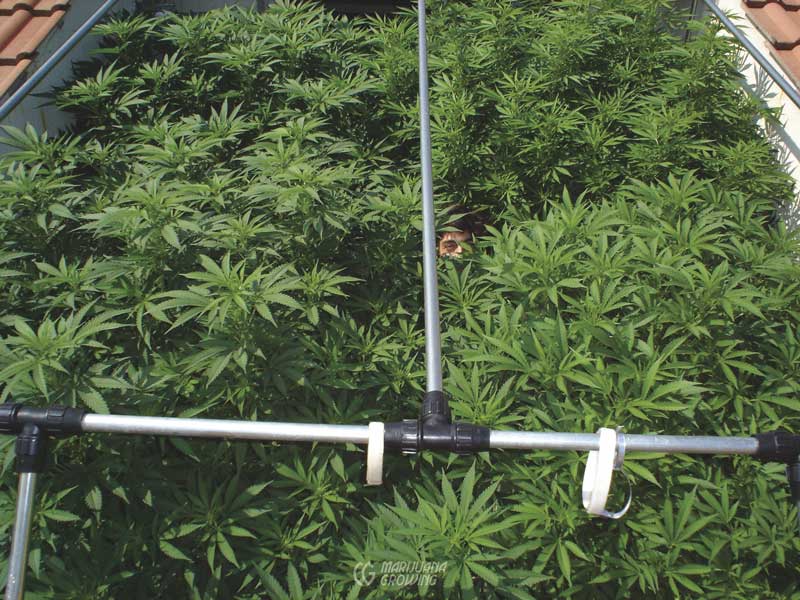
This rooftop garden is set up as a greenhouse. On rainy days and cold nights plastic is stretched over the top of the garden.

This photo from the same rooftop garden above shows how well buds grow under natural sunlight.
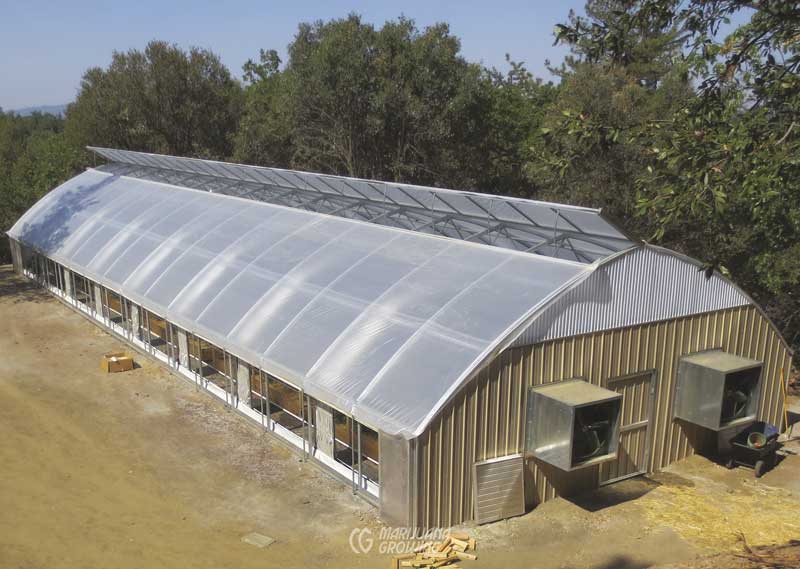
This brilliant grower cut the hillside away to site the greenhouse. It receives maximum sunlight all year and is protected from wind.
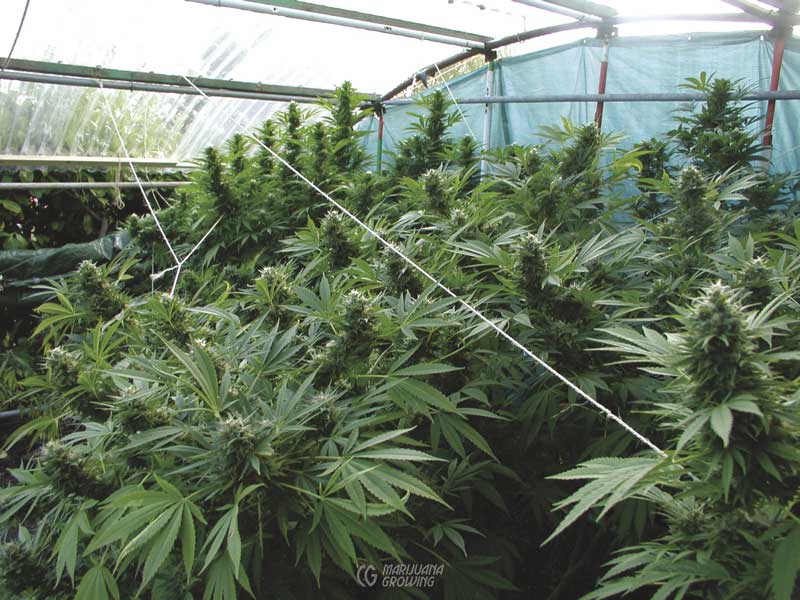
This nice little greenhouse garden was grown in France in a populated residential zone.
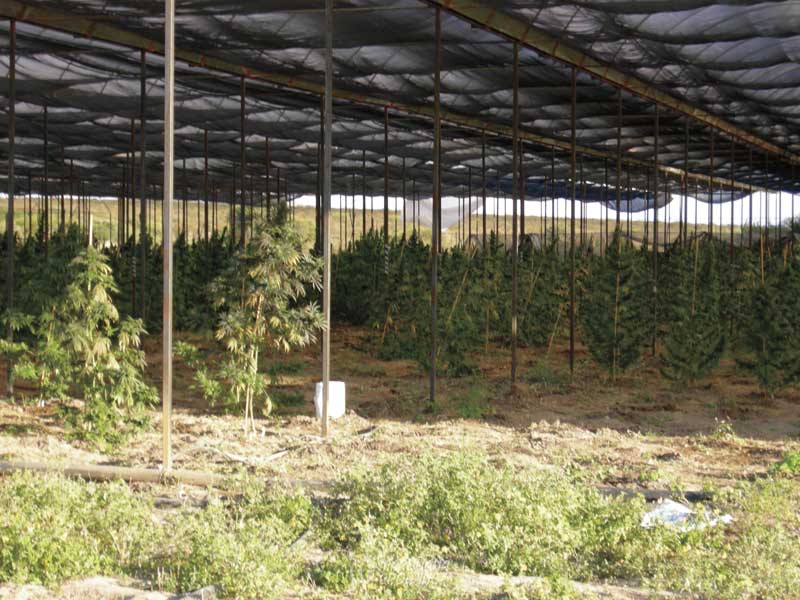
Shade cloth cuts intense heat from direct sunlight and creates a natural breezeway above plants. A covering of shade cloth cuts plants’ water consumption, lowers temperatures, and reduces plants’ stress levels.
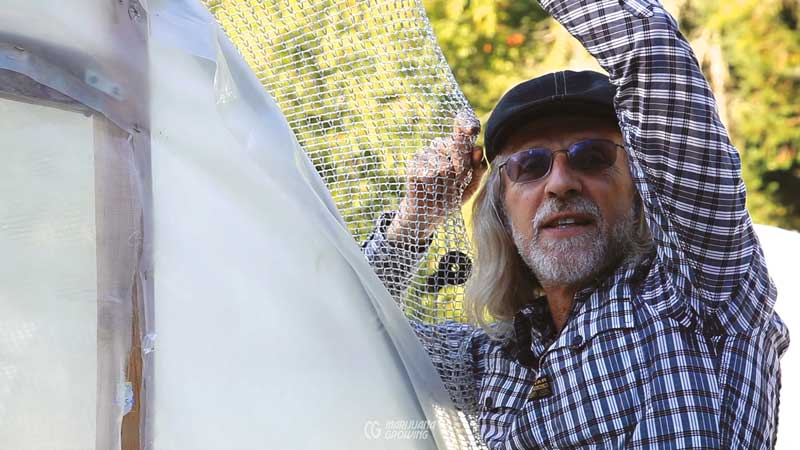
Jorge is holding up the Aluminet covering for this greenhouse. The high-tech shade cloth is lightweight and reflects intense heat from sunlight.
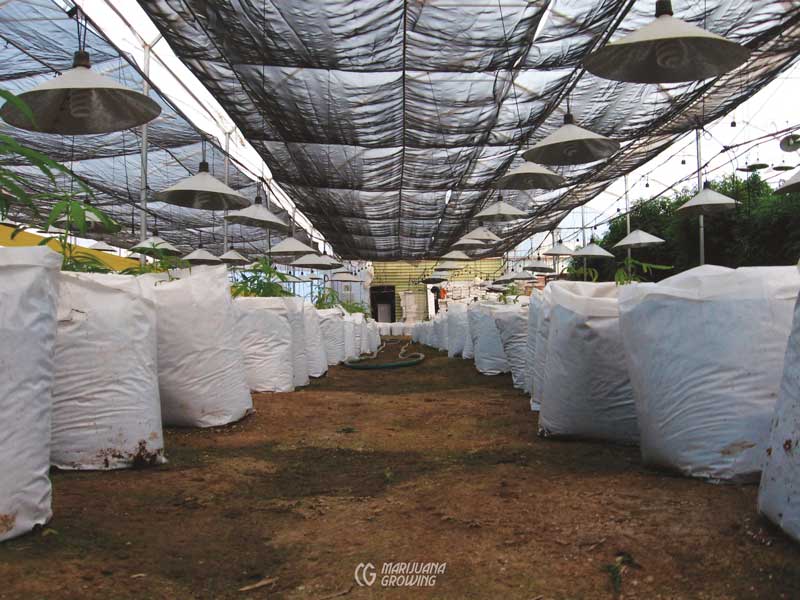
Shade cloth can be hung on part of the green- house to help nurture young plants. Large, well-established plants on the right receive full light.
Shade Coverings
Shade coverings serve to cool the greenhouse by blocking light transmission and, in turn, heat. Shade paint can be applied as a covering on the outer skin or glass of the structure. Reusable plastic shade film can cover the outside of the greenhouse or be fitted against rigid coverings inside. Roll-up shade coverings made of cloth or aluminum are flexible, removable, and reusable.
Shade paint is relatively easy to apply with a hose-end sprayer or a paint roller on a long pole. Water-based whitewash is inexpensive and easy to apply, although somewhat messy. Once applied, it can be washed off with a brush on an extended hose when sunlight intensity diminishes as the heat of summer passes. Remember, cannabis needs ample light to form big flower buds in the fall.
Colored plastic can also be used to shade plants. See “Plastic Skins” for more information.
Shade cloth is used to cover greenhouses to help keep them cool. It is available in different opacities—from 10 to 80 percent—and 3 predominant colors: green, black, and white. Traditionally a permeable cloth fabric, several new synthetic products, such as Aluminet, have emerged. This lightweight economical covering reflects heat and light as well as cutting light transmission.
Shade cloth can be used as the only covering for a greenhouse. It cuts light transmission, provides ventilation through the permeable cloth, and keeps pests and diseases outside.
Shade cloth, when used as a canopy with no greenhouse, creates a breezeway between plants and the cloth. The extra air circulation and ventilation provide added cooling. Used on the sides of the greenhouse, shade cloth is an excellent permeable windbreak. Shade cloth can also be affixed against walls or fences that are heated by sunlight. Attaching shade cloth to a fence can cut emitted heat by 20 to 30 degrees.
A lath house is built from thin, narrow strips of wood that allow filtered sun to enter the structure. In warm climates lath houses are a good place to take cuttings and harden-off plants grown indoors. Lath houses can provide 25 percent shade or more depending on the placement of the laths. Traditionally lath houses have been used to keep supplies, transplant, start seedlings, and so on.
Greenhouse construction and decision-making about greenhouse coverings are only the beginning. Growing plants in a greenhouse is often more demanding than growing plants indoors. Air temperature, humidity, light, and air quality must all be controlled in relation to a constantly changing greenhouse climate.
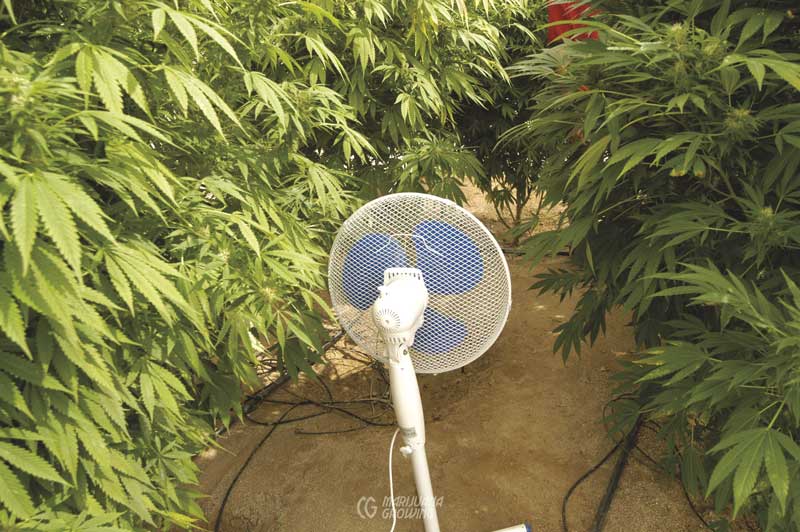
This gardener placed an oscillating fan on a stand in the middle of his greenhouse in order to increase air circulation between his flowering plants.
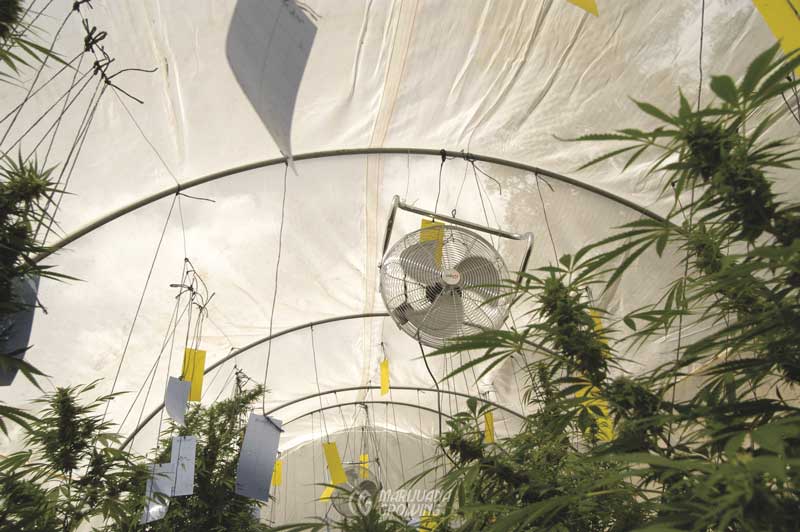
Setting up a ventilation fan was an afterthought in this greenhouse.
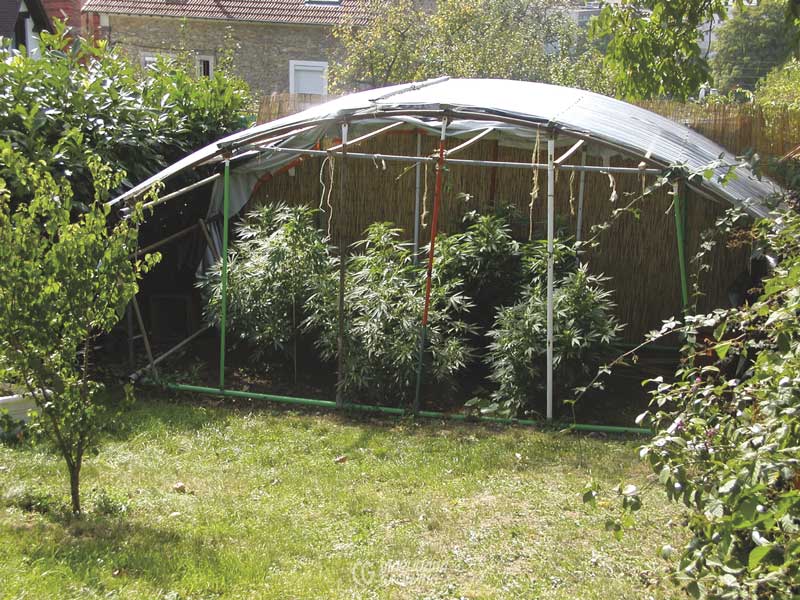
This backyard greenhouse garden in suburban Paris, France, uses the fence to hold heat and to block the neighbors’ view.
Climate Control
Greenhouses heat up quickly on sunny days and cool equally fast when the sun ducks behind a cloud or drops below the horizon. When the air inside the greenhouse cools, relative humidity rises, often beyond 100 percent. Water droplets condense on all surfaces—walls, ceiling, containers, and foliage. This fluctuation of heat and humidity is difficult and expensive to control. Temperature fluctuations also affect the ratio of nutrient to water that plants need and use, which makes growing in a greenhouse more demanding than growing indoors.
Air Circulation
The greenhouse must be big enough for air to circulate. A ratio of 33 percent plants to 63 percent air is ideal. Keeping air flowing inside small greenhouses is easy on a cool day, but when it heats up, air inside the greenhouse is trapped and temperatures climb beyond outdoor temperatures. Circulating greenhouse air is essential and may require large fans.
Small greenhouses can be cooled and heated relatively easily. Larger spaces are more demanding.
Condensation
Condensed water droplets that form on the inside of a greenhouse can reduce light transmission by up to 50 percent. Condensed droplets also attract fungus. Rainy and warm weather, increased plant transpiration, poor airflow and ventilation, and insufficient roof slope all contribute to condensation. Often a surface tension modifier is included in the greenhouse plastic to prevent formation of condensation droplets.
Condensation occurs because the greenhouse is warm and humid. When the temperature drops at night, hot air rises and condenses on plants and the ceiling of the greenhouse. If these drops do not run down the sides of the greenhouse, they block light transmission and are a source of problems. The little water droplets also spread disease. Not to mention how it feels to get a shower when you bump the wall of the greenhouse!
Condensation is especially bad when there are hot days and cool nights. The easiest way to ensure that condensation does not occur is to have an adequate ventilation system to remove humid air at sunset. Also, construct greenhouse ceiling/roof and sides with enough slope for gravity to carry condensed water droplets to the ground. Condensed water droplets can severely impair light transmission.
Even the best greenhouses will lose heat through radiation; conduction and convection through glass, walls, and floor (or soil); and also through vents, doors, and cracks. To counteract external variables, the internal structure of the greenhouse can be more complex than construction and siting.
Vents control temperatures in all seasons and improve growing conditions. Hand-operated roof vents will require frequent checks, or you may install automatic vents with an electric motor and thermostat that will respond to conditions around the clock. Venting is important with a cold frame, too. The high-end models have wax-filled vents that operate automatically, opening when the heat rises in the frame and contracting as the temperature cools. You can find the paraffin-filled “Optivent” and many other supplies at greenhouse supply centers.
Heating systems are important to keep plants healthy during cold nights. Cannabis thrives with nighttime temps of 60°F to 65°F (15.5°C–18.3°C), but colder nights call for an additional heat source for sustained growth.
All greenhouses need ventilation, and most greenhouses need fans. Look for an extraction fan with the capacity to change the air every 1 to 5 minutes.
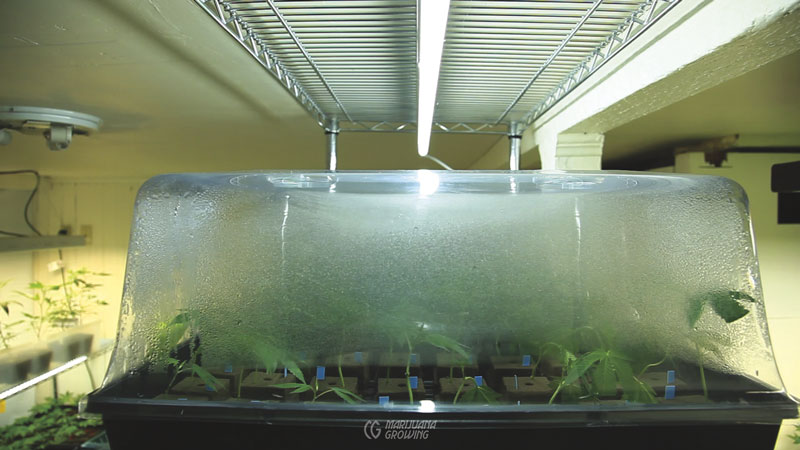
Water condenses out of the air when there is more humidity than the air can hold. Humidity condenses into moisture when humid air cools.
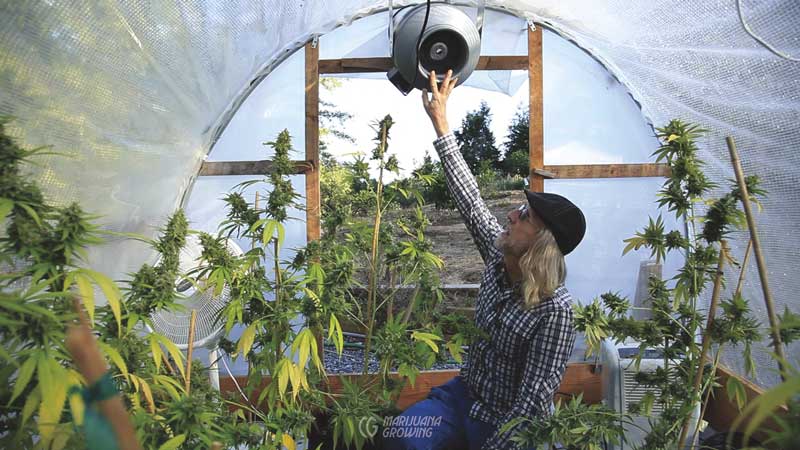
This super-efficient inline fan evacuates hot air near the ceiling of the greenhouse.
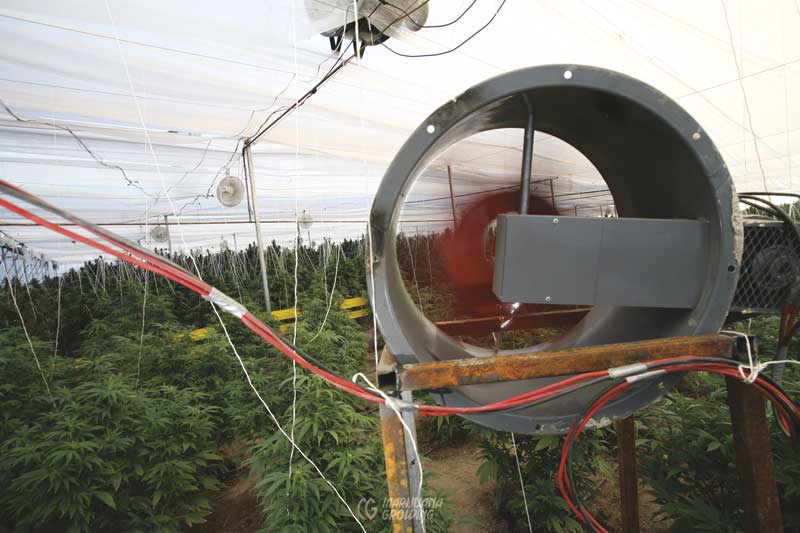
A high-rpm fan moves air across a large area.
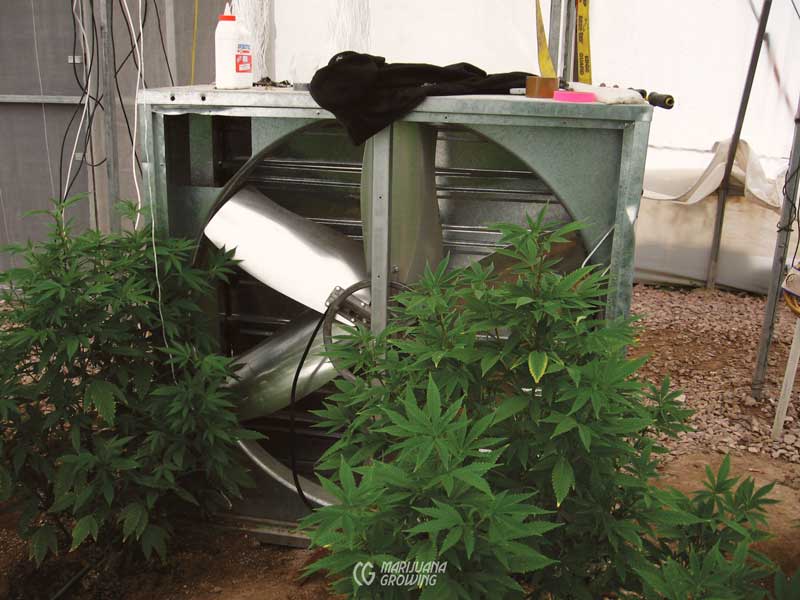
Sometimes vent fans break down!
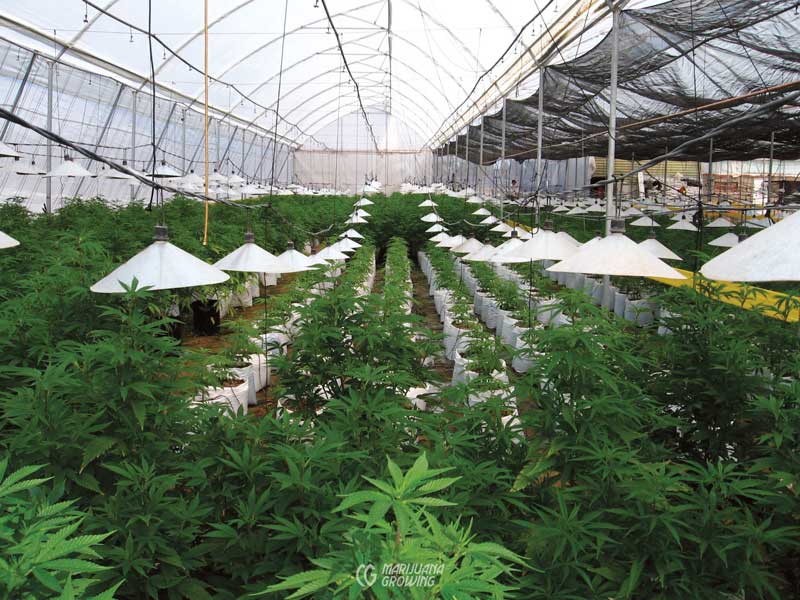
This large greenhouse has plenty of airspace inside, and hot air is vented out the top of the structure.
Cooling
Minimum-Impact Greenhouse Cooling
• Site in cool spot—shade or a natural breezeway
• Covering— insulate
• Vents—mechanical or automatic
• Shade cloth or shade covering
• Vent fans
• Humidity increase—misting
• Evaporative cooling
The eco-friendly way to cool a greenhouse is to take advantage of the microclimate. Locate it to receive shade or a breeze during the hottest part of the day and to have natural wind circulation. Greenhouses that receive full sun all day long must be covered with shade cloth or cooled artificially. This eco-friendly balance between time, money, and physical environment costs more resources in cold and hot climates. Warm climates are the most economical location for a greenhouse.
Evaporating water increases humidity and lowers temperature in a greenhouse. Make walkways out of gravel that drains and holds water that will dissipate into the air, creating humidity. Setting up misters to increase relative humidity is very effective in dry climates, but more expensive. Remember, increasing humidity could cause cultural problems if overdone or mismanaged. Excess water sitting on leaves or clinging to the inside of the greenhouse invites cultural, disease, and pest problems.
Venting off hot air is one of the fastest and easiest ways to cool greenhouses. Since heat rises, venting hot air from the top of the greenhouse is the most efficient. If natural breezes are not enough to keep the greenhouse cool, electric fans and evaporative cooling are the next options.
Louvers on vent fans also force the hottest, most humid air out while protecting the plants from draft. Installing louvers that close when vent fans are off will help prevent entry of pests. See chapter 16, Air, for more information.
Lifting the sides of the greenhouse serves as ventilation but is much less efficient than venting from the top. When greenhouse sides are lifted, much warm air still stays within the upper portion of the greenhouse.
Evaporative cooling eliminates excess heat and adds humidity, reducing water needs. Moist air circulates through the structure while warm air is expelled through roof vents or exhaust fans. Properly installed, an evaporative cooler can reduce interior temperature by as much as 30 to 40 degrees in hot, dry climates, less in wetter areas. As with fans, cooler size is determined by greenhouse size. A general guideline is to find a cooler equal to the total cubic space of the structure plus 50 percent.
Evaporative coolers are also known as swamp coolers because they introduce humid, swamplike air in order to cool homes and greenhouses. A typical greenhouse evaporative cooler consists of a big fan with large bats of straw or corrugated, concrete-impregnated pads that are fixed at the end of the greenhouse wall. Water is circulated through the pad. The large fan blows the humid air from the water-soaked pad into the greenhouse.
Air conditioners are very expensive to operate and are not practical in large greenhouses.
Misting and watering are important components of greenhouse gardening. Extended growing periods and higher sustained temperatures make adequate water essential. Again, there are methods to suit every temperament from low-tech to automatic. Most companies offer watering and misting systems by component, which can be mixed and matched to suit the grower’s needs.
Automatic misting systems are a good investment for busy or forgetful growers. The timer triggers the mist or water at preset intervals. You may want a toggle switch that allows you to rotate between manual and automatic watering. For more information on specific uses and types of watering systems, check out www.cloudtops.com. It has good information about misting systems for greenhouses. Atomize water for best results.
A lower-tech method of mist-and-watering control consists of a series of screens that tilt downward with the weight of the water shutting off the flow, and then raise to restart the cycle as the screens dry. It is fully automated by the weight of the water or lack thereof. Of course, there is also hand-watering, which is very effective and requires no mechanical intervention. Automatic systems, both high and low-tech, are alternatives to hand-watering that can be most helpful during a gardener’s absence.
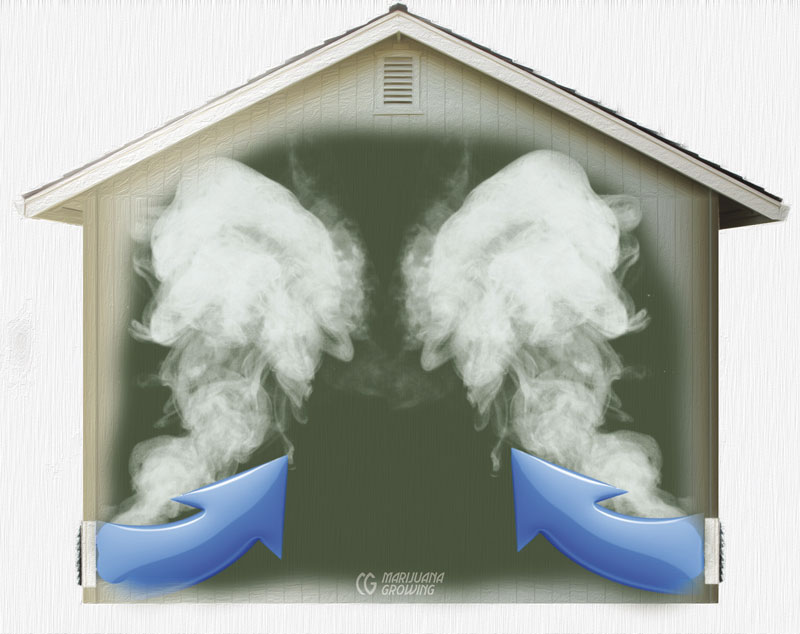
Bring fresh air into greenhouses and garden rooms from vents located near the floor, and expel stale air near the ceiling.
Heating
Heating a greenhouse with coal, gas, kerosene, electricity, or wood is expensive and often unnecessary or wasteful. Big greenhouse growers with permanent greenhouses can economically use a coal, wood, or gas boiler to supply hot water or steam through steel heating pipes run through the greenhouse. Environmentally conscious gardeners often grow in small greenhouses where steam heat is not a viable option. They heat greenhouses with the least expensive means and progressively invest resources according to the dynamics of the greenhouse. Closing all uncontrolled air leaks is the first step toward efficient, effective greenhouse heating. Next, control wall and ceiling insulation, soil heat, air temperature, and humidity.
- Close all cracks—enclose greenhouse
- Insulate skin—see “Coverings”
- Bank heat—install water barrels
- Insulate soil—thermal blanket
- Heat soil—manure/compost, soil
heating cables/mat - Heat air—water and stone bank, soil
bank, steam/water, gas, electricity
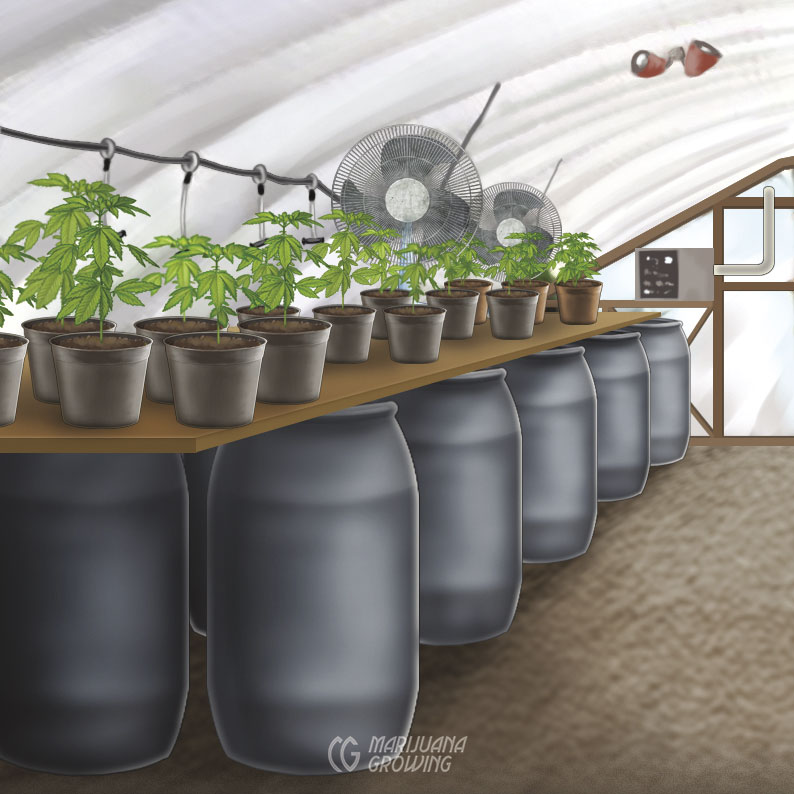
Large, black-painted drums full of water absorb heat from sunlight during the day. Heat is stored in the water, and at night it slowly dissipates into the greenhouse to warm the air.
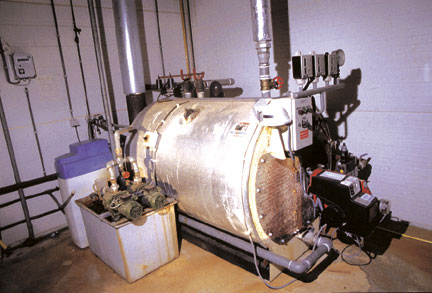
This is a photo of the original boiler that heated Sensi Seeds’ main indoor growing facility. Heating a greenhouse or large indoor garden is much more economical with a fuel-fed boiler.
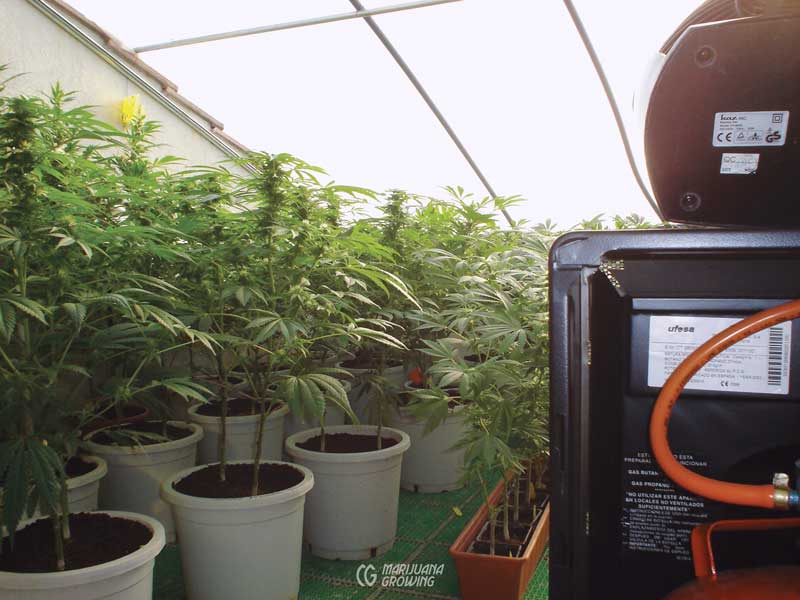
This small greenhouse is being heated with a propane gas heater.
Soil-heating cables with a thermostat are the most efficient use of electricity for heat when air temperatures get down to 50ºF (10ºC) at night and go up during the day. Place the cable on the soil at the bottom of the bed or on a bed of sand or vermiculite and cover with about 2 inches (5 cm) of sand. You will need to provide 10 to 15 watts of electric heat for every square foot (0.09 m2) of growing area. Heat cables are also useful in greenhouses for warming seedlings, clones, or flowering plants without the cost of heating the entire structure.
| Heat Source | Efficiency |
| warm floor (insulated) | 90% |
| warm floor (uninsulated) | 80% |
| hot water pipes | 85% |
| hot air heaters | 60% |
| HEATING-FUEL EFFICIENCY | ||
| Fuel | Efficiency (%) | Unit Heat Value |
| electricity | 95–100 | 3,413 Btu/kWh |
| natural gas | 80 | 1,000 Btu/ft3 |
| propane | 80–91 | 92,6290 Btu/gal |
Heating small greenhouses can be relatively economical with an electric space heater, or be more effectively heated with thermostatically controlled forced air using ducts or plastic tubing to evenly distribute the heat. Large greenhouses may be heated with forced air or by a coal or natural hot water or steam system. But both hot water and steam heating are expensive to install. The inexpensive, low-tech-but-labor-heavy method of greenhouse warming: compost. A grower in Portland, Oregon, stacks organic matter on the sides of the greenhouse to a height of about 5 feet (1.5 m) inside and out. The compost gives off heat as it decomposes, keeping the structure warm at a very low cost.
A CO2 burner also generates heat as a by-product. Closed greenhouses often have too little CO2 during the day for plants to be able to use light effectively. Increasing the level of CO2 with a generator will accelerate plant growth. An infrared sensor/controller can be attached to the CO2 generator to control it automatically. Detailed information on CO2 can be found in chapter 16, Air.
Big gas air heaters are available from horticultural supply stores. With a web browser, search for “greenhouse heater.” Everything from gas to electric to kerosene heaters will pop up. Remember to keep hot air from blowing directly on plants.
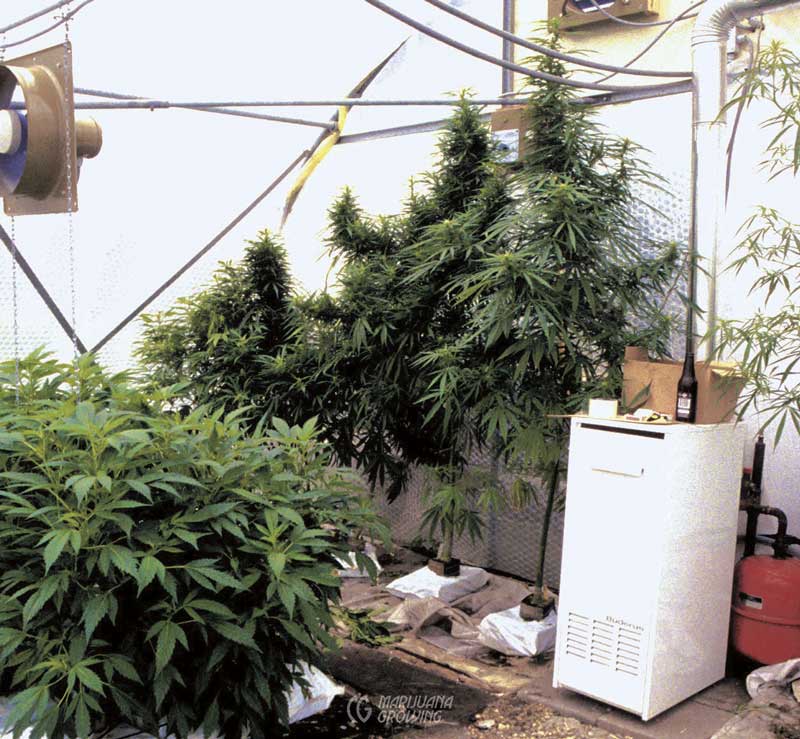
The white box is a gas heater. Notice how the plants are growing in short blocks of rockwool. This is how Nevil (Seed Bank, Holland, 1985) grew plants for breeding.
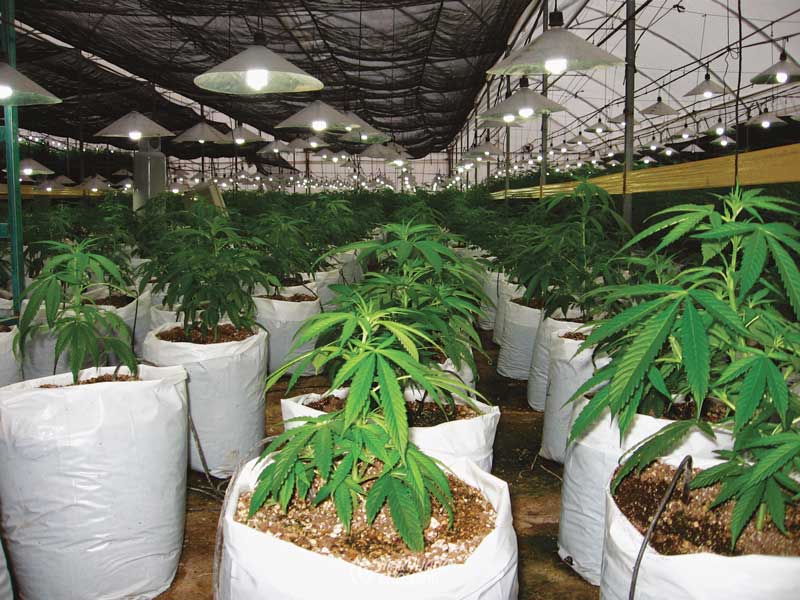
These CFLs do not throw a lot of light, but it is enough to keep these plants in the vegetative growth stage.
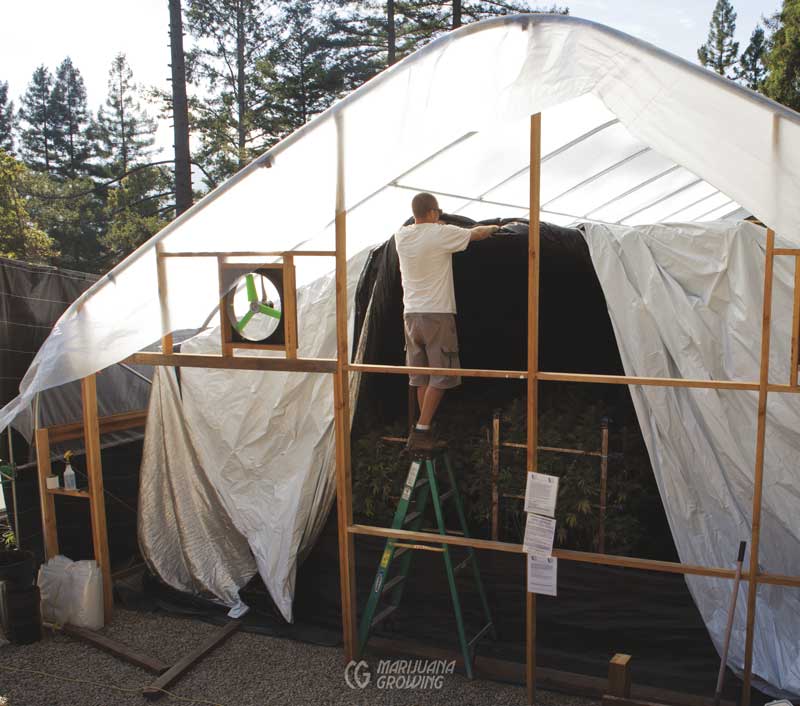
This grower covers his garden daily. He removes the shade covering after dark so that plants receive 12 hours each of light and dark. The plastic above protects the dark covering below from wind.
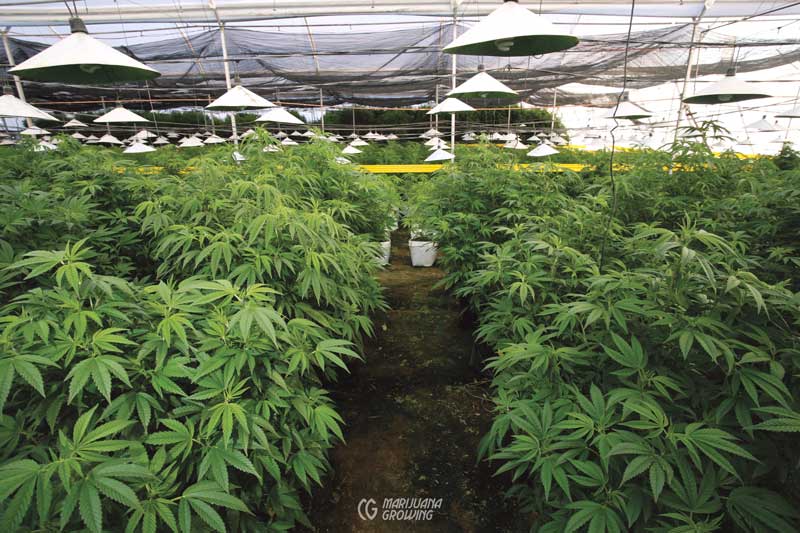
The CFL lamps above this garden are turned on at night to interrupt the dark period. The extra hour of light in the middle of the night is enough to keep these plants from flowering.
Artificial Lighting
When combined with natural sunlight, artificial light is most efficiently used in most climates during non-daylight hours. Above 50º north latitude, light intensity diminishes quickly in the fall, winter, and spring. Supplemental lighting is very effective in greenhouses in these northern latitudes. Anybody who has flown into Schiphol Airport in Amsterdam at night has seen the deep orange glow emitted by HPS lamps in greenhouses.
Greenhouse growers turn the HID lights on when sunlight diminishes (30 minutes before sunset) and off when sunlight strengthens (30 minutes after sunrise). Turn on the HPS when the daylight intensity is less than 2 times the intensity of the HPS. Measure this point with a light meter. Turn off the HPS when the daylight intensity is greater than 2 times the intensity of the HPS. A simple photocell that measures light intensity can be used to turn the lights on and off automatically when light levels fall below a specified level. Supplementary lighting has greatest effect when applied to the youngest plants.
It is least expensive and most efficient to light plants when they are small. These artificial lighting principles work for flowering and vegetative growth cycles.
Exclusively HPS lamps are used because natural sunlight supplies enough light in the rest of the spectrum. Lamps with small reflective hoods and attached ballasts are used in greenhouses. The small reflective hood blocks very little natural sunlight and the attached ballast delivers electricity more efficiently to the bulb.
Maintain vegetative growth in the spring with inexpensive CFL lights. Supplemental nighttime lighting is necessary to interrupt the dark period and prevent cannabis plants from flowering. The lighting can be from HPS lamps or small 60- to 75-watt equivalent CFL lamps. The small lamps are hung over plants and turned on for an hour or so in the middle of the night (dark period).
Small vegetative plants do not need as much light in the spring. This is when plants establish a big strong root system and strong vascular system. Once warm weather and long days arrive, plants really start to grow!
Light Deprivation
For many years Dutch growers, commercial growers, and other cannabis gardeners have been using “thermal blankets” in greenhouses to hold heat in at night and to black out greenhouses to simulate 12-hour nights and days that induce cannabis to flower. Darkening greenhouses to induce flowering during midsummer will allow 3 or more medicinal cannabis harvests annually in mild climates. Cannabis plants (except C. ruderalis)* flower when nights are long (12 hrs) and days are short (12 hrs). To induce flowering, darken the greenhouse so that plants receive 12 hours of uninterrupted darkness every day.
*Specific medicinal varieties may react differently to the light schedules outlined in this section. See chapter 3, Medical Cannabis Varieties, and chapter 25, Breeding, for more information.
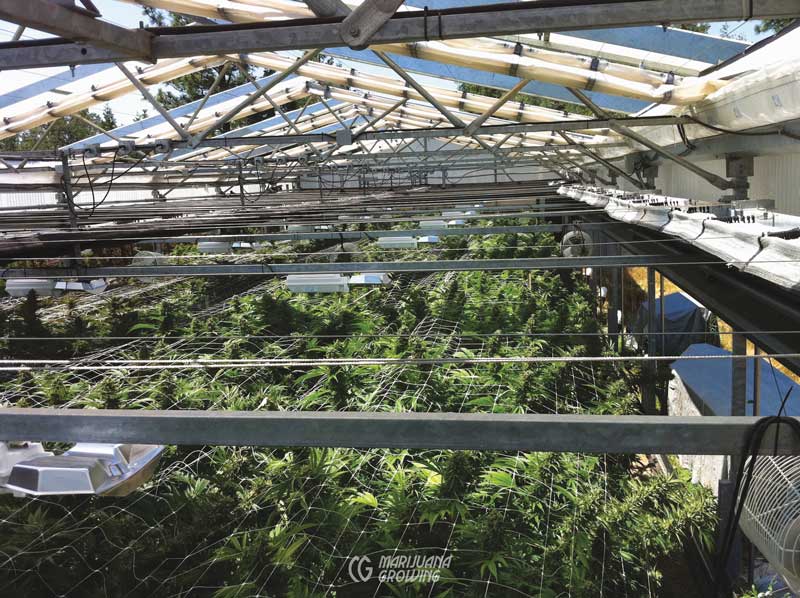
With this Forever Flowering greenhouse, a gardener is able to control the photoperiod during the entire year.
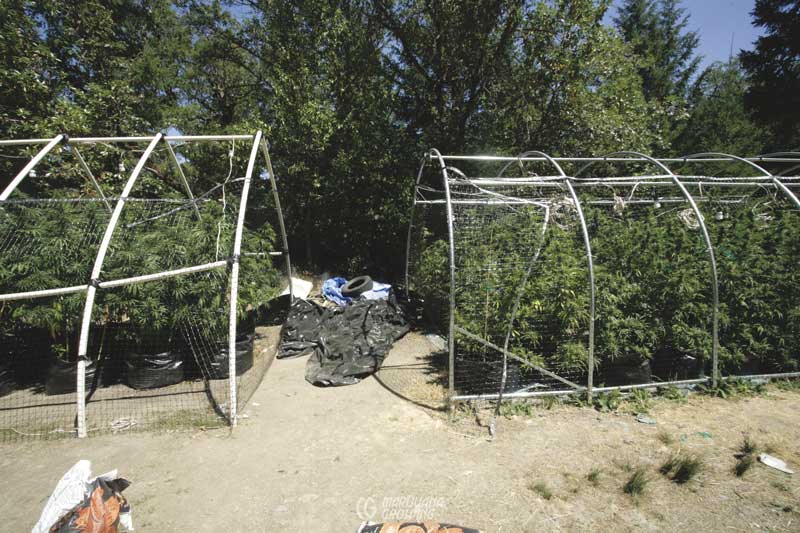
Both of these light-deprivation greenhouses are covered with black plastic every night.
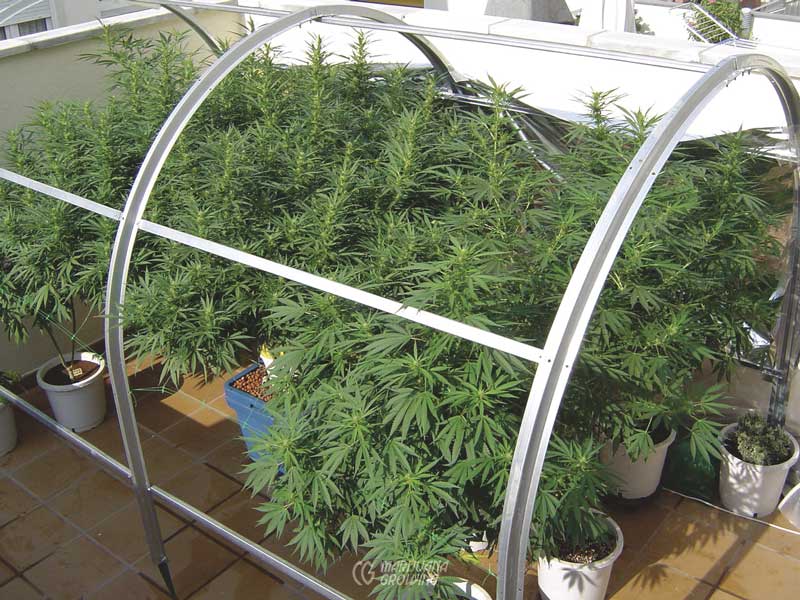
This greenhouse is blacked out by covering it with black plastic until darkness falls. The blackout plastic is removed at night.
Midsummer sunlight is much more intense than sunlight in the spring and fall. Cannabis requires high levels of light to produce the biggest and heaviest medicinal flower buds. Inducing cannabis to flower under high light levels will produce a heavier harvest.
Automatic darkening greenhouses can be constructed or purchased. (Designing and constructing an automatic-darkening greenhouse is beyond the scope of this book.) Automated greenhouses have different degrees of automation. There are many greenhouse companies that offer automatic darkening greenhouses. The most popular automated light deprivation greenhouses in the USA are from Forever Flowering. Search YouTube for videos that demonstrate how the greenhouses operate.
Imposing the day/night schedule to darken a greenhouse is not as difficult as it might appear, but it is a daily event. For example, the longest day of the year, June 21, can be 15 hours long; the greenhouse must be blacked out for 3 hours so that plants receive 12 hours of darkness.
Daily, at about the same time, the greenhouse must be blacked out. The darkening material must be removed after darkness falls, to ensure that plants are adequately ventilated during hot summer nights.
For example, if you black out a greenhouse at 7:00 a.m. and it is dark at 9:00 p.m., you can remove the cover from the greenhouse before going to bed. The ritual does not repeat until the next day/ night. Make sure the cover is lightweight and the entire “job” of covering the greenhouse is as easy as possible. I find that easy jobs are more likely to be completed regularly.
Tropical greenhouses from latitudes of 0º to 30º north and south receive from 12 to 13 hours of light/dark daily and do not need to be blacked out. In fact, to keep plants in vegetative growth, artificial light must be infused to keep plants from flowering.
In spring and fall, greenhouses do not need to be darkened to induce flowering, since darkness and daylight are close to 12 hours each. Check your latitude and the hours of light your garden receives to calculate the black-out period.
Use black opaque plastic to completely cover greenhouses. Small greenhouses are easy to cover by dragging the plastic over the superstructure of the greenhouse. Black plastic should be divided into 2 lighter-weight pieces to facilitate work when covering larger greenhouses.
Secure the bottoms of the plastic around the base of the greenhouse to prevent light from entering and wind from lifting the plastic. Use flexible elasticized bungi cords to secure the opaque covering to eyebolts along the bottom perimeter of the greenhouse. Toss ropes over the outside skin of the covered greenhouse to secure it from wind.
Store the black plastic alongside the greenhouse when not in use.
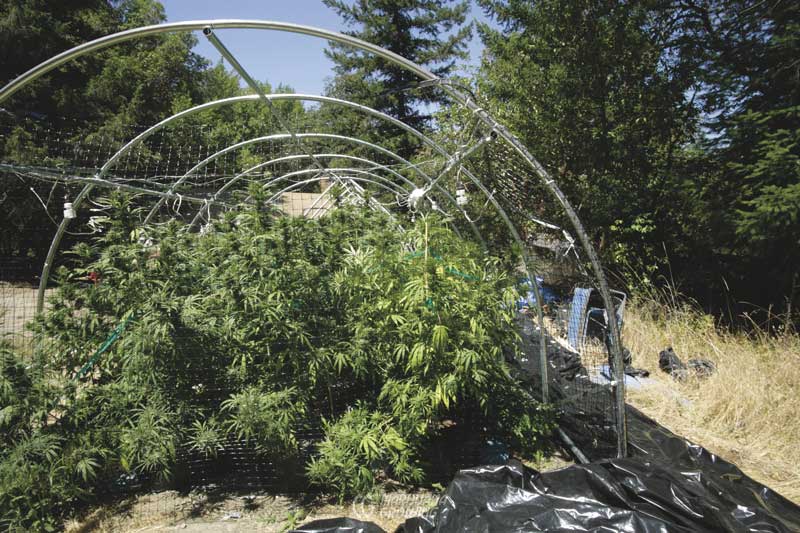
The black plastic on the right is stretched over the hoop house after plants receive 12 hours of light. The plastic is removed at night so plants are able to breathe.
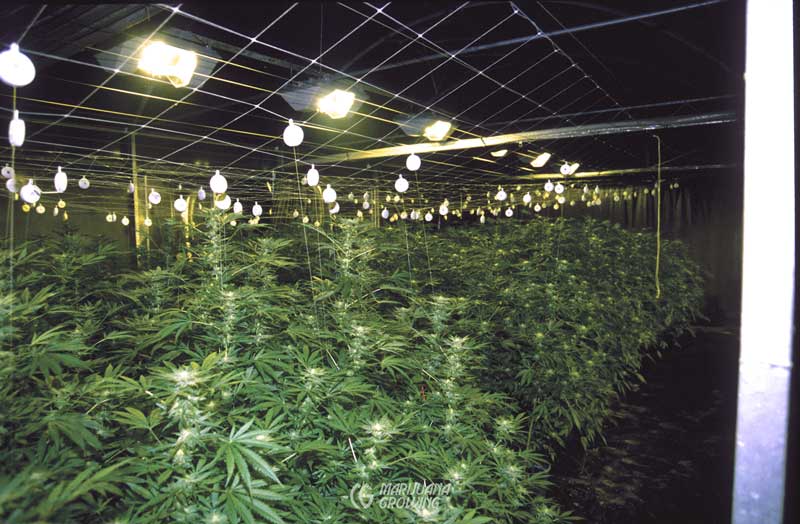
An automatic darkening system in a greenhouse at the Cannabis Castle in the Netherlands blacks out gardens to induce flowering. I shot this photo in 1986!

